
[Use in conjunction with Ginns, James. 2017. Polypores of British Columbia (Fungi: Basidiomycota). Prov. B.C., Victoria, B.C. Tech. Rep. 104. http://www.for.gov.bc.ca/hfd/pubs/Docs/Tr/TR104.htm ]
Of the nearly 230 polypores in the Pacific Northwest about 80 are treated in this key. Most are relatively common but some unusual or rare species are included. The initial version of this key by Daniel Stuntz was completed in the summer of 1980. Since then a large number of changes have been proposed in the circumscription of species and genera, new generic names have been widely accepted and new synonymy has been proposed. To reflect these and other changes extensive revisions have been made to the key and the Notes section has been completely rewritten. The North American Polypores by Gilbertson and Ryvarden (1986-1988) has been adopted as the standard for names of genera and species, technical terms, as well as for the characterization of the macro- and microscopic features for most species. Three new features are the addition of common names, references to color pictures of basidiocarps, and a glossary of technical terms.
Polypore is a term applied to fungi that produce basidiocarps that are predominately tough, leathery to woody, relatively large (mostly over 3 cm diameter), and typically grow on live or dead trees, logs, stumps and branches on the ground. The purpose of the basidiocarp is to produce the basidiospores that are essential for long distance spread of that fungus. In the polypores nearly all species produce the basidiospores on a microscopically thin layer that lines the inside of the pores rarely lamellae, as in Lenzites betulina and Gloeophyllum sepiarium) that form on the lower surface of the basidiocarp (below see diagram on right).

|
The features of the basidiocarps are based upon fresh specimens, unless otherwise specified. Measurements of sessile or laterally stipitate basidiocarps are given thus: 3-30 x 5-50 x 1-10 cm, which means the pileus is 3 to 30 cm deep from margin to point of attachment, measured at right angles to the substratum, is 5 to 50 cm wide from edge (margin) to edge in a line parallel to the substratum, and is 1 to 10 cm thick; see the diagram above.
To observe microscopic features one needs a very sharp razor blade, glass slide, cover slip and a liquid mounting medium (water will do, 2% potassium hydroxide (KOH) or Melzer's reagent are better). Very thin sections of basidiocarps can be placed in a drop of 2% KOH on a glass slide, covered with a cover-slip and observed with a microscope. Melzer's Reagent stains basidiospores, cystidia, hyphae, etc. blue if the cell(s) are amyloid or reddish brown if they are dextrinoid To save some space and eliminate repetition all species in the Key should be presumed to have basidiospores with hyaline, smooth, thin, nonamyloid, nondextrinoid walls, unless otherwise specified, and to lack cystidia and setae, unless otherwise specified.
At the end of most species descriptions in the Key there is a reference, such as Note 34, to additional information in the Appendix.
1a Basidiocarp with more than one tube layer (perennial)
................................................................................2
1b Basidiocarp with only one tube layer (annual)
................................................................................14
(Note: The first year of growth a perennial basidiocarps will have only one tube layer; if the basidiocarp is unusually hard, rigid and tough, go to #2)
2a Context and tube layers pink
................................................................................Fomitopsis cajanderi
| Pileus up to 6 x 10 cm, surface tomentose becoming crustose, pink becoming gray to black, margin pink when growing; context corky to rigid; tubes 0.5-3.0 mm deep; pore surface pink; pores round, 3-5 per mm. Basidiospores 5-7 x 1.5-2.0 μm, cylindrical, curved; context dimitic, generatives with clamp connections, skeletals 2.5-6.0 μm diameter. Color picture figure 524 in Lincoff (1994). Note 1. | Fomitopsis cajanderi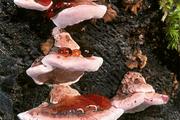 Boleslaw Kuznik |
2b Context and tube layers not pink
................................................................................3
3a Context reddish orange to rusty orange; confined to living juniper
................................................................................Pyrofomes demidoffii
Pileus ungulate, 3-10 x 4-15 x 2-14 cm, rigid, woody; pileus surface at first yellow-orange and tomentose, becoming gray to black and conspicuously cracked; context orange-cinnamon; tubes 5-10 mm deep; pore surface yellow to yellowish brown; pores 2-3 per mm, round, regular.
Basidiospores 6-12 x 5-7 μm, ovoid to broadly ellipsoid, typically truncated, walls faintly brown, thick; context dimitic, generatives with clamps, skeletals rusty brown to golden yellow, trama distinctly dextrinoid. Note 2.
3b Context not reddish orange to rusty orange; rarely on living juniper
................................................................................4
4a Pores white to cream color; immediately turning brown where bruised or scratched
................................................................................Ganoderma applanatum
| Pileus 3-30 x 5-50 x 1-10 cm, applanate to rarely ungulate, surface a hard crust, gray to black with white to cream colored margin when growing, often rusty brown due to a deposit of basidiospores; context rigid, tough-corky, brown then becoming white progressively from surface downward in older specimens; tubes 4-12 mm deep; pores round, 4-6 per mm. Basidiospores 6-9 x 4-6 μm, ovoid, truncated, walls brown, thickened, with internal spaces or pockets, and apical germ pore; context trimitic, generatives with clamps. Color picture figure 518 in Lincoff (1994). Note 3. | Ganoderma applanatum.jpg) Ganoderma applanatum 1 Michael Wood (MykoWeb) |
4b Pore surface variously colored, if white or cream, then not turning brown where touched
................................................................................5
5a Context dark brown to rusty brown, xanthochroic
................................................................................6
5b Context white, ivory, cream color or beige
................................................................................9
6a Basidiocarps resupinate
................................................................................Phellinus ferruginosus
| Basidiocarps from a few cm to several decimeters long, rusty brown; context and stratified tubes up to 3.5 cm thick, rigid but rather soft; tubes about 3 mm deep; pores 7-9 per mm, round. Basidiospores 5-7 x 3-3.5 μm, cylindric to short-oblong; setae numerous in hymenium, subulate, 25-65 x 6-8 μm; setal hyphae in margin; context dimitic, generatives lack clamps. Note 4. | Phellinus ferruginosus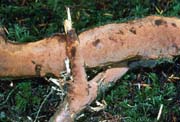 Michael Beug |
6b Basidiocarps pileate, sessile
................................................................................7
7a Pileus rough-hispid, conspicuously concentrically grooved and feeling like coarse sandpaper
................................................................................Phellinus pini
| Pileus 6-15 x 4-25 x 1-15 cm, applanate to triquetrous or ungulate, black; margin thin, brown; context rusty brown, hard, woody, buried tubes indistinctly stratified; tubes 2-6 mm deep; pore surface brown; pores round, 2-3 per mm, or labyrinthiform and larger. Basidiospores 4-6 x 3.5-5 μm, globose or subglobose; setae in the hymenium, 10-14 μm diameter; context dimitic, generatives lack clamps, skeletals brown. Note 5. | Phellinus pini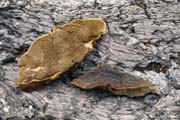 Steve Trudell |
7b Pileus with a hard, smooth crust, not concentrically grooved, and not feeling like coarse sandpaper even in young specimens
................................................................................8
8a Pileus dark gray to black; tubes of the buried layers stuffed with material, forming white streaks in the dark brown context of the interior
................................................................................Phellinus igniarius
| Pileus 3-15 x 5-20 x 3-20 cm, ungulate, crusted, dark slate gray to black, smooth at first but becoming deeply cracked; context dark brown, hard, rigid; pore surface gray to brown; pores round, 4-5 per mm. Basidiospores 5-6.5 x 4-5 μm, subglobose; setae present in the hymenium; context dimitic, generatives lack clamps, skeletals brown. Color picture figure 530 in Lincoff (1994). Note 6. | Phellinus igniarius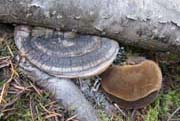 Michael Beug |
8b Pileus resembling a horse's hoof, gray; tubes of buried layers hollow, and continuous from layer to layer; no white streaks
................................................................................Fomes fomentarius
| Pileus 3-15 x 6-20 x 2-15 cm, ungulate, crustose, glabrous, smooth, not cracked, some shade of gray, margin brown in growing basidiocarps; context brown, soft-corky or punky; tubes of any one season about 6 mm deep, not distinctly stratified; pore surface brown; pores round, 3-4 per mm. Basidiospores 17-20(-27) x 5-7(-11) μm, ellipsoid; context trimitic, generatives with clamps, skeletals brown. Color picture figure 527 in Lincoff (1994). Note 7. | Fomes fomentarius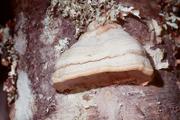 Michael Beug |
9a (5) Basidiocarp resupinate
................................................................................Perenniporia subacida (see # 59b)
9b Basidiocarp pileate or effuse reflexed
................................................................................10
10a Pileus surface a dense, doormat-like mat 2-5 cm thick
................................................................................Bridgeoporus nobilissimus
Basidiocarps massive, up to 140 x 95 x 100 cm; pileus applanate to triquetrous, the surface layer white when young, then dingy beige on older parts, of loosely interwoven, coarse, strigose hyphal bundles; margin in growing specimens white; tubes 5-7 mm deep, conspicuously stratified with a white mat 1-3 mm thick between each layer; pore surface white to cream color; pores round or angular, 3-5 per mm.
Basidiospores 5-7 x 3.5-5 μm, oval; cystidia in hymenium 30 x l3 μm with crystals at the apex; context monomitic, lacking clamps. Note 8.
10b Pileus surface glabrous, crustose, chalk-like or papery, at most thinly tomentose or fibrillose, lacking a thick strigose layer
................................................................................11
11a Pileus surface a paper-thin, glabrous pellicle that soon wears away, exposing the white, chalky, friable context, taste very bitter
................................................................................Fomitopsis officinalis
| Pileus convex to ungulate when young, becoming cylindrical when older, seldom remaining ungulate, up to 31 cm deep, 20 cm wide, or often larger especially in vertically elongate, cylindrical specimens; tubes conspicuously stratified, 3-20 mm deep; pore surface beige brown in functional basidiocarps, worn away in dead ones; pores 3-4 per mm. Basidiospores 4-5.5 x 3-4 μm, ellipsoid; context trimitic. Color picture figure 529 in Lincoff (1994). Note 9. | Fomitopsis officinalis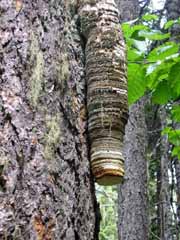 Ken Melamed |
11b Pileus surface with a dense, hard crust that does not wear away; context tough-fibrous or woody, not chalky and friable, taste mild or slightly acid
................................................................................12
12a Pileus with a red or red-brown, dull or shiny varnished band next to the white or pallid growing margin
................................................................................Fomitopsis pinicola
| Pileus 4-30 x 6-40 x 3-22 cm, applanate, triquetrous or ungulate, surface resinous-crusted, smooth, glabrous, gray to black; context pallid when young, straw color with age, very tough, rigid, woody; tubes distinctly stratified, 3-11 mm deep; pore surface white to ivory, pale straw color with age; pores round, 2-3 per mm. Basidiospores 6-8 x 3.5-4 μm, cylindrical; context trimitic, generatives with clamps, skeletals straight, walls thick, hyaline. Color picture figure 531 in Lincoff (1994). Note 10. | Fomitopsis pinicola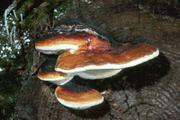 Michael Beug |
12b Pileus lacking a red-varnished band next to the margin
................................................................................13
13a Pileus surface brown or on oldest parts black, concentrically grooved, pitted and ridged, rough to the touch; pileus thin and applanate even when several years old
................................................................................Heterobasidion annosum
| Pileus 1-15 x 2-25 x 1-7 cm, sessile or effuse-reflexed; context thin, pale yellow, rigid, woody; tubes distinctly stratified, 2-10 mm deep; pore surface cream color to yellow; pores round to angular, 2-3 per mm. Basidiospores subglobose, 3.5-5 x 3-4 μm, finely echinulate; context dimitic, generatives lacking clamps; skeletals dextrinoid. Color picture figure 519 in Lincoff (1994). Note 11. | Heterobasidion annosum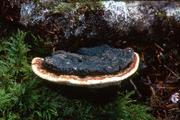 Michael Beug |
13b Pileus surface gray to black, smooth, not pitted and ridged; pileus in old specimens convex to ungulate
................................................................................Fomitopsis pinicola (see # 12a)
14a (1) Context rose color, red, or orange
................................................................................15
14b Context white, ivory, cream color, yellow, beige, or brown
................................................................................18
15a Context and tubes rose color, pink, or brownish pink; basidiocarps hard, rigid, tough-woody
................................................................................Fomitopsis cajanderi (see # 2a)
15b Context and tubes red (vermilion) or orange
................................................................................16
16a Pore surface bright cinnabar red
................................................................................Pycnoporus cinnabarinus
| Pileus 2-7 x 2-12 x 1-2 cm, sessile, semicircular to conchate, surface appressed-tomentose, red; context red to orange-red, zonate, soft-fibrous or soft-corky; tubes 2-6 mm deep; pore surface smooth, red; pores 2-4 per mm, round to angular, occasionally daedaleoid. Basidiospores 4.5-6 x 2-3 μm, oblong-ellipsoid; context trimitic, generatives with clamps. Color picture figure 512 in Lincoff (1994). Note 12. | Pycnoporus cinnabarinus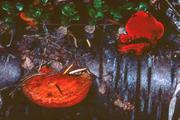 Michael Beug |
16b Pore surface not bright cinnabar red
................................................................................17
17a Basidiocarps resupinate or effuse-reflexed; pores large, 1-3 mm diameter, orange with white edges, soon becoming irpiciform
................................................................................Pycnoporellus alboluteus
| Pileus surface when present orange, rough-fibrillose; context orange, soft-fibrous, becoming cherry red with KOH; tubes 10-20 mm deep, walls orange with white, irregular, jagged edges. Basidiospores 6-10 x 3-4 μm, cylindrical; leptocystidia 50-100 x 6-12 μm, cylindrical, walls hyaline, thin; context monomitic; generatives lack clamps. Color picture figure 747 in Lincoff (1994). Note 13. | Pycnoporellus alboluteus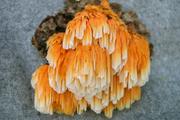 Andrew Parker |
17b Basidiocarps pileate-sessile; pores smaller, 1-2 per mm, becoming lacerate to irpiciform only in old specimens
................................................................................Pycnoporellus fulgens
Pileus
2-8 x 4-12 x 1-3 cm, semicircular, surface
appressed-fibrillose becoming almost glabrous, orange to reddish orange;
context orange, soft-fibrous, red then quickly black with KOH;
tubes 2-6 mm deep, orange, with lacerate edges, finally becoming
irpiciform; pore surface light orange to orange; pores 1-2 per mm,
angular to sinuous.
Basidiospores 5-9 x 2.5-4 μm, oblong-ellipsoid; leptocystidia few, cylindrical, 12-35 x 3.5-8 μm; context monomitic; generatives lack clamps. Note 14.
18a (14) Pileus with lamellae instead of pores
................................................................................19
18b Pileus with pores, no lamellae
................................................................................22
19a Lamellae lavender to purple
................................................................................Trichaptum laricinum
19b Lamellae lack lavender and purple colors
................................................................................20
20a Pileus surface densely hairy, tomentose or hispid, zonate; context white
................................................................................Lenzites betulina
| Basidiocarps sessile, rarely effuse-reflexed, 2-8 x 2-12 x 0.5-1 cm; pileus, semicircular, applanate, gray to grayish beige; context 1-2 mm thick, tough, leathery; lamellae radiating from point of attachment to margin, in several lengths, thin but tough-leathery, white becoming cream to dingy pale
ochraceous. Basidiospores 4-7 x 2-3 μm, cylindrical; cystidia lacking but tapered thick-walled branches of binding hyphae, that are abundant in lamellar trama, often projecting into the hymenium; context trimitic, generatives with clamps, skeletals and binding hyphae thick-walled, predominate. Color picture figure 535 in Lincoff (1994). Note 15. | Lenzites betulina.jpg) Michael Wood (MykoWeb) |
20b Pileus surface glabrous or nearly so, never conspicuously hairy or tomentose; color of context varies
................................................................................21
21a Context bright rusty brown, xanthochroic
................................................................................Gloeophyllum sepiarium
| Pileus 1-5 x 2-8 x 0.5-1.0 cm, semicircular, applanate, often with several laterally confluent, surface rusty brown, weathering to gray, zonate, frequently wrinkled or furrowed; context 1-4 mm, tough-leathery; lamellae 2-5 mm broad, brown, tough-leathery. Basidiospores 8-12 x 3-4 μm, cylindrical; cystidia (metuloids) numerous, brown, thick-walled, 20-40 x 4-8 μm, scarcely or not projecting beyond the hymenium; context trimitic; generatives with clamps; skeletals thick-walled, brown; binding hyphae rare. Color picture figure 516 in Lincoff (1994). Note 16. | Gloeophyllum sepiarium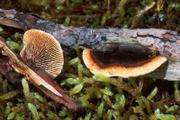 Michael Beug |
21b Context pallid to beige or even dark beige (wood brown), but if dark beige giving only a false xanthochroic reaction
................................................................................Daedaleopsis confragosa (see # 76a)
22a (18) Pore surface concave, surrounded by the projecting curb-like pileus margin; pileus surface with a paper thin, whitish, smoky to brown, suede-like pellicle; only on dead birch
................................................................................Piptoporus betulinus
| Pileus 3-15 x 3-25 x 1-5 (-10) cm, oval, semicircular, conchate or reniform, attached by a lateral knob-like tubercle; context thick, white, very tough, leathery; tubes 2-8 mm deep, the tube layer separating as a whole from the context in fresh specimens; pore surface white to cream; pores round, 5-6 per mm. Basidiospores 3.5-6 x 1-2 μm, allantoid; context dimitic; generatives with clamps; skeletals thick-walled or solid, hyaline. Color picture figure 491 in Lincoff (1994). Note 17. | Piptoporus betulinus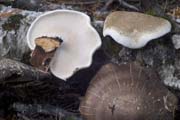 Andrew Parker |
22b Neither pore surface nor pileus surface as in the above
................................................................................23
23a Basidiocarps with central, eccentric or lateral stipe, or having the rosette growth habit
................................................................................24
23b Basidiocarps neither stipitate nor with rosette growth habit, but instead pileate-sessile, effuse-reflexed or resupinate
................................................................................49
24a Basidiocarps having the rosette growth habit
................................................................................25
24b Basidiocarps growing singly, not in a rosette; two or more may become confluent, i.e., their edges touch
................................................................................30
25a Context rusty brown to dark brown
................................................................................26
25b Context white, pallid or at most beige
................................................................................27
26a Pores green, quickly becoming brown where bruised; context soft, fleshy-fibrous, brittle
................................................................................Phaeolus schweinitzii
| Basidiocarps fan-shaped to circular, up to 17 cm broad, often forming rosettes 15-24 cm or more in diameter; pileus surface tomentose, hispid, rough, concentrically zoned, brown; margin yellow in growing condition; context brown, xanthochroic; tubes 4-8 mm deep; pore surface green when growing, brown when aged; pores round, 1-3 per mm or angular or labyrinthiform. Basidiospores 5-8 x 4-5 μm, ellipsoid or oval; leptocystidia cylindrical, 30-150 x 6-20 μm; context monomitic, generatives 3-17 μm diameter, thin-walled, lack clamps. Color pictures number 153 in Arora (1986) and figure 480 in Lincoff (1994). Note 18. | Phaeolus schweinitzii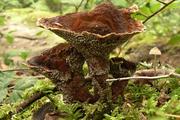 Rich Mably |
26b Pores gray to beige or brown, only bruising brown when growing (gray); context tough-fibrous
................................................................................Inonotus tomentosus
| Basidiocarps typically stipitate; pileus fan-shaped to circular, 3-18 cm broad, surface soft, velvety, soft-tomentose, yellowish brown; context duplex (but not always distinctly so), upper layer 3-10 mm thick, tomentose, lower layer 1-3 mm thick, firm, compact; tubes 2-10 mm deep; pores 2-4 per mm, round to angular. Basidiospores 4-7 x 3-5 μm, yellow; setae 30-65 x 7-17 μm; context monomitic, generatives lack clamps, hyaline to golden yellow. Color picture figure 448 in Lincoff (1994). Note 19. | Inonotus tomentosus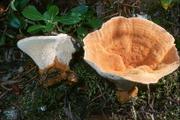 Michael Beug |
27a (25b) Rosettes large, up to 30-50 cm diameter; flesh about 1 cm thick
................................................................................28
27b Rosettes smaller, up to 12 cm diameter; flesh typically less than 1 cm thick
................................................................................29
28a On the ground, typically at the base of living conifers
................................................................................Bondarzewia montana
| Basidiocarps typically large clusters of imbricate pilei; pileus fan-shaped, 8-15 cm broad, arising from a common base, brown, surface pubescent, drying hispid; context soft, brittle, drying rigid-brittle, white; pore surface cream color; tubes 2-5 mm deep; pores large, 0.5-2.0 mm diam, angular, irregular. Basidiospores globose, 5-7 μm diam, ridged, strongly amyloid; context dimitic, generatives lack clamps. Note 20. | Bondarzewia montana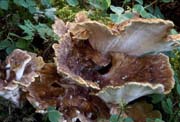 Steve Trudell |
28b On the ground under hardwoods (especially maple)
................................................................................Bondarzewia berkeleyi
| Basidiocarps typically large clusters of imbricate pilei, rosettes up to 50 cm broad; pileus 6-25 cm broad, surface straw color to beige; context white, soft, brittle, drying rigid and brittle; tubes 2-5 mm deep; pore surface white to cream; pores 1-2 mm diam, angular or irregular. Basidiospores globose, 6-8 μm diam, ridged, strongly amyloid; context dimitic, generatives lack clamps. Note 20. | Bondarzewia berkeleyi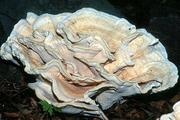 Pamela Kaminski |
29a (27) Pileus surface with alternating concentric zones, velvety and silky-appressed, the silky ones orange or some similar color, the velvety zones gray or tinged green (from algae)
................................................................................Trametes versicolor (see # 88b)
29b Pileus surface not zonate, or if it is, then all the zones are hirsute or tomentose, and the same color, typically gray
................................................................................Trametes hirsuta (see # 88a)
30a (24) Context rusty brown to dark brown, xanthochroic
................................................................................31
30b Context white, ivory, cream color, yellow, or beige; no reaction with KOH, or at most a false xanthochroic reaction
................................................................................33
31a Pores green, quickly becoming brown where bruised
................................................................................Phaeolus schweinitzii (see # 26a)
31b Pores not green, but instead gray or beige or brown (may become darker brown when bruised, or not)
................................................................................32
32a Context 1-3 mm thick, not duplex
................................................................................Coltricia perennis
| Basidiocarps stipitate, stipe central, infrequently eccentric, 2-7 cm long, 1-10 mm thick, solid, surface velvety, brown; pileus circular in outline, funnel-shaped or flat or slightly convex, 3-11 cm broad, surface appressed-fibrillose, often silky and shining, sometimes dull, usually concentrically zoned, rusty brown to dull brown, may weather gray; tubes 1-3 mm deep; pore surface yellow-brown to brown or sometimes gray; pores 2-4 per mm, angular to round. Basidiospores 6-9 x 3-5 μm, inequilaterally almond-shaped, pale brown; context monomitic; generatives lack clamps. Note 21. | Coltricia perennis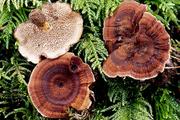 Cy and Mary Hampson |
32b Context 4-15 mm thick, duplex
................................................................................Inonotus tomentosus (see # 26b)
33a (30b) Pileus and stipe with shiny varnished surface
................................................................................Ganoderma oregonense (see # 81a)
33b Pileus and stipe lack shiny varnished surface
................................................................................34
34a Basidiocarp pileus and stem surfaces hispid and brown, odor of iodine evident soon after picking
................................................................................Jahnoporus hirtus
| Basidiocarps stipitate; stem eccentric or lateral, 2-8 cm long, 1-2 cm thick, solid, core hard, white, fibrous, surface hispid and brown like the pileus; pileus 4-15 cm broad, spathulate, fan-shaped, reniform or conchate, surface hispid, covered with short stiff, erect hairs, gray-brown to dark brown; context 3-20 mm thick, firm, white; tubes 2-6 mm deep; pore surface white when fresh, ivory or cream color in age; pores 1-2 per mm, round to irregular, edges notched. Basidiospores 12-17 x 4.5-6 μm, fusiform or boletoid; context monomitic; generatives with clamps. Color picture figure 465 in Lincoff (1994). Note 22. | Jahnoporus hirtus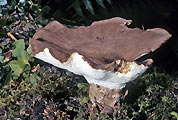 Kit Scates Barnhart |
34b Basidiocarps lacking an odor of iodine
................................................................................35
35a Basidiocarps arising from soil, not attached to wood, always stipitate
................................................................................36
35b Basidiocarps attached to wood, most species lack a stipe
................................................................................42
36a Pileus surface densely covered with coarse, pointed, recurved or erect fibrous scales
................................................................................37
36b Pileus surface lacking erect or recurved scales, but rather smooth, glabrous, or like suede; at most becoming areolate-cracked when dry
................................................................................38
37a All surfaces, especially the pore surface, staining green where bruised
................................................................................Albatrellus ellisii
| Basidiocarps stipitate; stem eccentric to lateral, 8-10 cm long, 4-5 cm thick, yellow; pileus 10-20 (-30) cm broad, fan-shaped or spathulate or half-funnel shaped, yellow to brownish yellow or greenish brown; context fleshy, brittle, up to 2 cm thick, white, becoming green where exposed; tubes decurrent on the stem, 2-5 mm deep; pore surface white, yellow in age; pores 0.5-1.0 mm diam, usually with uneven edges. Basidiospores 8-9 x 5-7 μm, ellipsoid; context monomitic; generatives with clamps. Color pictures figures 420 and 456 in Lincoff (1994). Note 23. | Albatrellus ellisii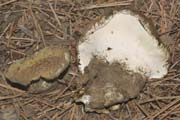 John Plischke |
37b Basidiocarp not staining green
................................................................................Albatrellus pes-caprae
Basidiocarps
stipitate; stem eccentric to lateral (usually), 3-8 cm long, 1-4 cm thick,
rigid, surface reticulate above; pileus 10-20 cm broad, fan-shaped or
nearly conchate, densely fibrillose-scaly to squarrose, dingy brown to
red-brown; context 1-2 cm thick, white; tubes decurrent upon the
stem, 2-5 mm deep; pore surface white, becoming yellow to greenish
yellow, sometimes tending to stain red-brown where bruised; pores 1-2 mm
wide, angular.
Basidiospores 8-11 x 5-6 μm, ovoid; context monomitic; generatives with clamps.
Color picture figure 464 in Lincoff (1994). Note 23.
38a (36) Pileus white, ivory, pale cream color, or pale blue or with blue tints
................................................................................39
38b Pileus gray to black, fading to cinnamon buff to olivaceous tawny
................................................................................41
39a Pileus gray, gray-white to pale ivory or pale cream color
................................................................................Albatrellus ovinus
| Basidiocarps stipitate, typically with clusters of 3-5 caps; stem central to eccentric, rarely lateral, 3-8 cm long, 1-3 cm thick, solid, surface smooth, white; pileus 4-12 (-15) cm broad, circular to oval; margin regular or lobed; surface suede-like or glabrous, when old cracking at center, staining yellow; context 5-15 mm thick, white, fleshy, brittle when fresh; tubes 1-3 mm deep, decurrent upon the stem; pore surface white, ivory, or sometimes yellow; pores 2-4 per mm. Basidiospores 3.5-4 x 2.5-3.5 μm, ovoid; context monomitic; generatives lack clamps. Color picture figure 460 in Lincoff (1994). Note 24. | Albatrellus ovinus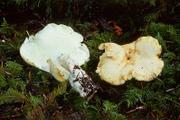 Michael Beug |
39b Pileus pale blue or with blue tints
................................................................................40
40a Pileus fading to pale orange with blue tints, typically over 4 cm diameter, context over 2 mm thick
................................................................................Albatrellus flettii
| Basidiocarps stipitate, stem 6-10 cm long, 2-3 cm thick, solid, smooth, white; pileus 5-10 (-26) cm broad, circular or frequently irregular in outline, smooth, glabrous or suede-like; context white, fleshy, tough to brittle; tubes 2-7 mm deep, decurrent; pore surface white at first, becoming apricot color to salmon when aged; pores 1-4 per mm, angular or round. Basidiospores 4-5 x 2.8-3.6 μm, broadly ellipsoid, weakly amyloid; context monomitic, generatives 4-15 μm diameter with clamps. Color picture figure 462 in Lincoff (1994). Note 24. | Albatrellus flettii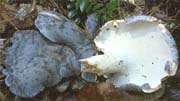 Boleslaw Kuznik |
40b Pileus not fading, up to 4 cm diameter, context up to 1 mm thick
................................................................................Albatrellus caeruleoporus
41a (38) Pileus dull gray to blackish gray
................................................................................Boletopsis subsquamosa
| Pileus 5-15 (-20) cm broad, round, convex; margin entire to undulating, downcurved becoming plane; surface glabrous, smooth; context 1-3 cm thick, white, drying black, firm, fleshy; tubes 2-8 mm deep; pore surface white, becoming pale gray; pores 2-4 per mm, angular. Stem central to eccentric, 4-8 cm long, 1-3 cm thick, cylindrical, solid, hard, surface dull, matte. Basidiospores subglobose, 5-7 μm diam to oblong, 5-6 x 4-5 μm, angular-nodulose, very irregular, hyaline to pale brown; context monomitic; generatives with clamps. Note 25. | Boletopsis subsquamosa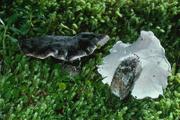 Michael Beug |
41b Pileus dark purplish gray, fading to cinnamon buff to olivaceous tawny
................................................................................Polyporoletus sublividus
Basidiocarps arising from the needle layer, laterally or centrally stipitate; pileus circular to lobed, up to 18 cm diameter, surface pale olive gray with patches of orange yellow, soft, chamois- or suede-like; margin bright green; context 2.5 cm thick, texture like that of a giant puffball, white, passing through lilac gray where tissue compacted in slicing, slowly (after several hours) becoming primrose yellow to warm buff or pale greenish yellow to orange yellow; trama becoming weakly green where handled and a thin (0.5mm thick) green line developing between tubes and context; tubes to 7 mm long; pores 0.5-1 per mm, round to angular, some radially elongated, mouths grayish white.
Basidiospores subglobose to broadly ellipsoid, 10-12 x 8-10 μm, wall appearing slightly roughened, thickened and unique in appearing to be composed of thin inner and outer layers held apart by pillars or short walls.
42a (35) Pores angular (hexagonal or diamond-shaped), definitely radially elongated (in lines from stem to margin)
................................................................................43
42b Pores round, several per mm; if rather angular then not in radially aligned
................................................................................45
43a Basidiocarps large; pileus up to 60 cm broad, 5 cm thick; pores large, 1-2 mm wide and 1-10 mm long in a radial direction
................................................................................Polyporus squamosus
Pileus semicircular to fan-shaped or reniform, surface cream color to ochraceous with numerous large brown appressed scales, becoming darker brown with age; context fleshy-tough, white; tubes 2-8 mm deep, decurrent; pore surface white to ivory or cream color; pores hexagonal to diamond shaped. Stem eccentric to lateral, 3-10 cm long, 1-5 cm thick, solid, hard, surface at apex reticulate from the decurrent pores,
velvety, brown to black in lower portion.
Basidiospores
10-15 (-18) x 4-6 μm, cylindric or boletoid; hyphal pegs may be present; context dimitic; generatives with clamps; binding hyphae dendritic.
Color picture figure 507 in Lincoff
(1994). Note 26.
43b Basidiocarps smaller, 2-10 cm broad, 2-4 mm thick; pores 0.5-3.0 mm long in radial direction or smaller
................................................................................44
44a Margin of the pileus with a fringe of hairs (ciliate); pores averaging 0.5-1.0 mm in radial direction
................................................................................Polyporus arcularius
| Basidiocarps stipitate, stem 2-6 cm x 2-4 mm, central, yellow-brown to dark brown; pileus 2.5 cm broad, round, centrally depressed, yellowish brown, appressed-scaly; context 2 mm or less thick, tough, white; tubes 1-2 mm deep; pore surface white or yellowish; pores up to 3 x 2 mm, hexagonal or diamond-shaped. Basidiospores 7-9 x 2.3-3 μm, cylindrical; context dimitic; generatives with clamps; binding hyphae dendritic. Color picture figure 509 in Lincoff (1994). Note 27. | Polyporus arcularius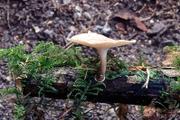 Cy and Mary Hampson |
44b Margin of pileus lacking a fringe of hairs; pores 1-2 per mm
................................................................................Polyporus brumalis
| Basidiocarps stipitate, stem 2-6 cm x 2-6 mm, central, minutely flocculose becoming glabrous, gray or brown; pileus 1.5-5 (-8) cm broad, round, centrally depressed with arched margin, glabrous to minutely hispid, sometimes appressed-scaly, dark brown to dark red-brown; context 2 mm thick, white; tubes 1-3 mm deep; pore surface white to cream; pores angular, elongated radially especially toward the stem. Basidiospores 6-7.5 x 2-2.5 μm, cylindrical; context dimitic; generatives with clamps; binding hyphae dendritic. Color picture figure 375 in Lincoff (1994). Note 27. | Polyporus brumalis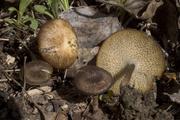 Andrew Parker |
45a (42) Stem white or cream color, glabrous; context dense and hard when fresh, drying bone-hard
................................................................................Oligoporus obductus (see # 89a)
45b Stem black and minutely velvety or gray to brown and glabrous, but not both white or cream and glabrous; context may dry rigid or corky, but not hard as a bone
................................................................................46
46a Stem gray to brown, glabrous when mature
................................................................................Polyporus brumalis (see # 44b)
46b Stem black, at least in the lower half, usually entirely minutely velvety
................................................................................47
47a Pileus pale chestnut brown to dark red-brown to almost black
................................................................................Polyporus badius
| Basidiocarps stipitate, stem 1-6 cm long, 1-2 cm thick, hard, tough, surface minutely velvety, black; pileus 4-15 cm broad, round to fan-shaped, convex, glabrous, chestnut brown or dark red-brown, almost black when old; context 1-5 mm thick, white or pallid, tough-leathery; tubes 2-4 mm deep; pore surface white to tan; pores round. Basidiospores 7.5-9 x 3-3.5 μm, cylindrical; hyphal pegs present; context trimitic; generatives inconspicuous, lack clamps; skeletals 2-7 μm diameter; binding hyphae dendritic. Color picture figure 543 in Lincoff (1994). Note 28. | Polyporus badius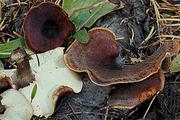 Boleslaw Kuznik |
47b Pileus pale tan to ocher, yellowish tan or dingy tan, may fade to almost white
................................................................................48
48a Pileus pale tan to ocher, often fading to almost white, without radial striations; pores 5-7 per mm
................................................................................Polyporus elegans
Basidiocarps stipitate, stem 5-8 cm long, 2-6 mm thick, central, eccentric or lateral, pruinose, entirely black or some black only at the base; pileus 2-7 cm broad, plane or shallowly convex, often umbilicate, glabrous; context 1-3 mm thick, white, tough; tubes 1-3 mm deep; pore surface gray to pale reddish brown; pores 5-7 per mm, round to angular.
Basidiospores 7.5-10 x 2.5-3 μm, cylindrical; hyphal pegs present; context dimitic; generatives with clamps; binding hyphae dendritic. Note 28.
48b Pileus yellowish tan or dingy tan, with darker radial striations; pores 7-9 per mm
................................................................................Polyporus varius
Basidiocarps stipitate, stem central to eccentric or lateral, 1-6 cm long, 1-2 cm thick, tough, dense, hard, surface minutely velvety, entirely black or black only at the base; pileus 5-12 cm broad, round to reniform or fan-shaped, tan, yellowish tan or dingy tan, usually with radial streaks of lighter color, glabrous; context 2-5 (-10) mm thick, white, leathery-tough; tubes 1-2 mm, deep; pore surface white, pale ocher or pale bay; pores round to angular.
Basidiospores 9-12 x 2.5-3 μm, cylindrical; hyphal pegs present; context dimitic; generatives with clamps; binding hyphae dendritic.
Color picture figure 453 in Lincoff (1994). Note
28.
49a (23) Pores covered by a thick membrane except for a single hole next to the point of attachment; develops in spring
................................................................................Cryptoporus volvatus
| Pileus 1-8 cm broad, sessile, knob-like, subglobose, surface pale yellow brown, smooth, glabrous, hard, varnish-like; context style="FONT-SIZE: 10pt; FONT-FAMILY: 'WP MathA'">"1 cm thick, corky, tough, white or pallid; tubes 2-5 mm deep; pore surface white to beige, often obscured by a dense spore deposit; pores round, 3-4 per mm, mouths even to lacerate. Basidiospores 8-12 x 3-5 μm, cylindrical; context trimitic; generatives with clamps. Color picture figure 528 in Lincoff (1994). Note 29. | Cryptoporus volvatus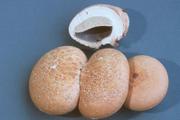 Michael Beug |
49b Tube layer not covered by a membrane
................................................................................50
50a Basidiocarp effuse
................................................................................51
50b Basidiocarp pileate or effuse-reflexed
................................................................................61
51a Context dark brown to rusty brown
................................................................................52
51b Context white, ivory, cream color, straw color or beige
................................................................................54
52a Basidiocarps growing only on charred wood; pores 1-2 per mm, angular or hexagonal
................................................................................Gloeophyllum carbonarium
Basidiocarps covering areas up to 30 cm long and proportionally wide, soft, flexible; context up to1 mm thick, soft, fibrous; tubes 1-5 mm deep; pore surface gray, becoming beige then umber brown with age.
Basidiospores 7-9 x 2-3 μm, cylindrical to allantoid; context dimitic; generatives with clamps; skeletals thick-walled, yellow. Note 30.
52b Basidiocarps not growing on charred wood; pores round, 4-6 per mm
................................................................................53
53a Basidiocarps very hard, rigid, woody; margin with a crust
................................................................................Phellinus igniarius (see # 8a)
53b Basidiocarps corky to fibrous, not hard and woody; margin fibrous, not crust-like
................................................................................Phellinus ferruginosus (see # 6a)
54a (51) Hymenophore irpiciform, entirely or at least in the older parts of the basidiocarp
................................................................................55
54b Basidiocarp not irpiciform, even in the older parts
................................................................................56
55a Hymenophore lavender, violet or purple, at least toward the margin
................................................................................Trichaptum abietinum (see # 67a)
55b Hymenophore white to ivory, never with violet or purple colors, even when young
................................................................................Irpex lacteus (see # 70b)
56a (54) Basidiocarp very dense, hard, rigid and woody; margin crust-like, brown or black
................................................................................Heterobasidion annosum (see # 13a)
56b Basidiocarp corky or fibrous, not rigid and woody; margin not crust-like
................................................................................57
57a Pore surface pink, rose color, brick red or dull salmon
................................................................................Junghuhnia nitida
Basidiocarps
covering 10 cm or more of substrate; margin white, pubescent;
context about 0.5 mm thick, white; tubes 0.5-1.5 mm deep;
pores 5-7 per mm, round to angular.
Basidiospores
3-5 x 2-3 μm, oblong-ellipsoid; cystidia crystal incrusted, thick-walled, abundant; context dimitic; generatives lack clamps.
Note 31.
57b Pore surface white, cream or pale straw color
................................................................................58
58a Pores 2-5 per mm or 4-6 per mm
................................................................................59
58b Pores 2 mm or more in diameter
................................................................................60
59a Pore surface white
................................................................................Antrodia serialis
Basidiocarps effuse, rarely narrowly reflexed, often in patches 15-20 cm diameter on the cut ends of logs, or in larger patches on horizontal surfaces; context up to 1 mm thick; tubes 2-5 mm deep (deeper if on nearly vertical surfaces, and tending also to be split down one side); pores 2-5 per mm, round to angular.
Basidiospores 5-9 x 2-3 μm, cylindrical or boletoid; context trimitic; generatives with rare clamps; skeletals unbranched, hyaline, not dextrinoid; bindings much branched, thick-walled. Note
32.
59b Pore surface cream color to yellow
................................................................................Perenniporia subacida
| Basidiocarps effuse, often forming large patches; context 1-2 mm thick, white to cream color; tubes 4-5 mm deep, the layer(s) corky, rigid when dry; pores 4-6 per mm, round or angular. Basidiospores 4-5.5 (-7) x 3-4 μm, subglobose, usually with the apex truncate; cystidia small sometimes present in the hymenium; hyphal pegs present; context dimitic, generatives with clamps; skeletals unbranched, walls thick, dextrinoid. Note 33. | Perenniporia subacida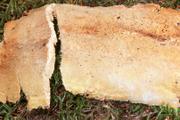 Michael Beug |
60a (58) Context thin, up to 1 mm thick
................................................................................Antrodia variiformis
Basidiocarps effuse to effuse-reflexed, rarely sessile, covering large areas of the under surface of logs of spruce (Picea spp.) and hemlock (Tsuga spp.); context cream color; tubes up to 3 mm deep; pore surface white to cream color; pores 2 mm in diameter, angular.
Basidiospores 7-8 x 2.5-3 μm, cylindrical or boletoid; context trimitic; generatives with clamps; skeletals unbranched; binding hyphae thick-walled. Note 32.
60b Context 3-6 mm thick
................................................................................Antrodia heteromorpha
Basidiocarps sessile to effuse, commonly imbricate, usually covering large patches on the lower surface of conifer and occasionally hardwood slash; context waxy or corky, white; tubes 3-10 mm deep; pore surface cream color or pallid; pores 2 mm diameter, angular.
Basidiospores 10-16 x 3.5-4 μm, boletoid; context dimitic; generatives with clamps; skeletals thick-walled, unbranched. Note 32.
61a (50) Context yellow brown to rusty brown to dark brown
................................................................................62
61b Context white, ivory, cream color, straw color or beige
................................................................................66
62a Basidiocarps with anise odor when fresh
................................................................................Gloeophyllum odoratum
Pileus up to 4 x 13 x 3 cm, semicircular to elongated, often confluent, surface yellow brown to reddish brown, tomentose to strigose, in age becoming glabrous; context up to 2 cm thick, dark yellow brown to dark brown, corky-rigid, xanthochroic; tubes up to 10-15 mm deep; pore surface cinnamon to dark brown; pores 1-3 per mm, round to angular or sometimes radially elongated.
Basidiospores 10-14 x 3-4 μm, boletoid; cystidioles subulate, 20-30 x 6 μm; context trimitic; generatives with clamps; skeletals unbranched, brown; binding hyphae solid, branched. Note 34.
62b Basidiocarps lacking anise odor when fresh
................................................................................63
63a Pore surface green when fresh, quickly turning brown where bruised; basidiocarps soft, fleshy-brittle when fresh
................................................................................Phaeolus schweinitzii (see # 26a)
63b Pores yellow or gray or brown, not green when fresh, not usually turning brown where bruised
................................................................................64
64a Basidiocarps growing on conifers; pileus surface soft-velvety
................................................................................Inonotus circinatus
| Pileus applanate or triquetrous, often imbricate, 3-8 cm wide, yellowish brown to dark brown, margin yellow when growing; context duplex, upper layer soft-tomentose, yellow brown, xanthochroic, lower layer hard, rigid, rusty brown; tubes 2-8 mm deep; pore surface pallid to yellow, becoming brown with age; pores 1-4 per mm, round to angular. Basidiospores 5-7 x 3-5 μm, ellipsoid; setae with hooked tips (circinate); context monomitic; generatives lack clamps. Note 19. | Inonotus circinatus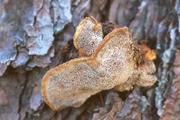 Michael Beug |
64b Basidiocarps growing on cottonwood and occasionally on other hardwood trees; pileus surface tomentose to rough-hispid
................................................................................65
65a Typically on cottonwood logs and stumps; pores 1-2 mm in diam, angular to hexagonal; pileus surface coarsely hispid, rough to the touch
................................................................................Coriolopsis gallica
Pileus up to 4 x 13 x 4 cm, semicircular to conchate or elongated, often laterally confluent, pale brown becoming gray; context yellowish brown to dark brown, black with KOH (false xanthochroic reaction); tubes 3-10 (-20) mm deep; pore surface gray to grayish brown.
Basidiospores 10-15 x 4-5 μm, cylindrical; hyphal pegs present; context trimitic; generatives with clamps; binding hyphae solid. Note 35.
65b Pores 1-3 per mm, angular, not hexagonal; pileus surface short-tomentose to fibrillose, soft to the touch
................................................................................Trametes trogii
Pileus 2.5 x 5 x 0.5 cm, semicircular, often laterally confluent, tan to light brown; context 2 mm thick, pale brown, corky; tubes 3-7 mm deep; pore surface whitish to pale brownish; pores sometimes becoming irpiciform.
Basidiospores 8-10 x 2.5-3 μm, cylindrical; context trimitic; generatives with clamps; skeletals hyaline, unbranched; binding hyphae solid, intricately branched. Note 35.
66a (61) Hymenophore irpiciform
................................................................................67
66b Hymenophore not irpiciform
................................................................................71
67a Hymenophore with lavender, violet or purple colors, at least toward the margin
................................................................................Trichaptum abietinum
| Basidiocarps often effuse-reflexed; pileus 1-4 x 1-4 x 0.1-0.2 cm, semicircular or conchate, pliable, soft-leathery, surface white to gray, tomentose to strigose, often zonate; context up to 1 mm thick, white to gray, occasionally gray-brown; tubes 1-3 mm deep, soon irpiciform, rarely remaining tubular; pore surface jagged, very uneven; pores 2-4 per mm, angular to labyrinthiform before splitting. Basidiospores 4-6 (-8) x 1.5-2.5 (-3) μm, cylindrical or allantoid; cystidia crystal-capped, 14-30 x 4-7 μm; context dimitic; generatives with clamps; skeletals branched only at the tips. Note 36. | Trichaptum abietinum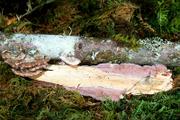 Michael Beug |
67b Hymenophore not lavender, purple or violet
................................................................................68
68a Hymenophore light gray to slate gray to almost black
................................................................................69
68b Hymenophore white to cream, some with a pink tint
................................................................................70
69a Pileus context duplex, upper layer densely hirsute
................................................................................Cerrena unicolor
| Basidiocarps often effuse-reflexed; pileus 1-7 x 2-10 x 1-3 cm, semicircular or conchate, concentrically zoned, often imbricate, corky-rigid, gray to light brown, growing margin white; context duplex, upper layer separated from the dense compact lower layer by a thin black line; tubes 2-5 mm deep; pore surface pale to dark gray, very uneven; pores elongated to labyrinthiform, then irpiciform. Basidiospores 4.5-6.5 x 3-3.5 μm, oval; context trimitic; generatives thin- to thick-walled, with clamps. Color picture figure 540 in Lincoff (1994). Note 37. | Cerrena unicolor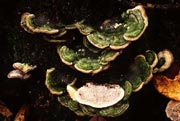 Tom Volk |
69b Pileus context not duplex; glabrous or at most finely pubescent
................................................................................Daedaleopsis confragosa (see # 76a)
70a (68) Poroid, pileus context duplex, with an upper cottony, marshmallow-soft layer 1-2 cm thick
................................................................................Oligoporus leucospongia (see # 73a)
70b Irpicoid with few pores, pileus context not duplex; only 0.1-0.6 cm thick, surface appressed-tomentose with a thin layer of fibrils
................................................................................Irpex lacteus
Basidiocarps effuse-reflexed, pileus narrow, elongated, 1.5 x 1-4 x 0.1-0.6 cm, often laterally confluent, often imbricate, white or milk-white, leathery; context 1 mm or less thick; hymenophore a series of flattened, irregular spines, no pores formed at the growing margin, white to cream color.
Basidiospores 5-7 x 2-3 μm, cylindrical; cystidia hyaline, crystal-incrusted, projecting up to 50 μm beyond the hymenium; context dimitic; generatives lack clamps; skeletals thick-walled to solid, hyaline.
Color picture figure 584 in Lincoff (1994). Note 38.
71a (66) Pileus surface shining as though varnished or lacquered
................................................................................Ganoderma oregonense (see # 81a)
71b Pileus surface not shining as though varnished
................................................................................72
72a Basidiocarps sessile, imbricate, large (15-20 cm broad); pileus surface pale salmon orange to bright orange; pore surface bright yellow
................................................................................Laetiporus conifericola
| Pileus 3-25 x 4-30 x 1-2.5 cm, convex becoming plane or nearly so, fan-shaped, conchate, applanate, frequently in large imbricate masses, surface rugose, dry, appressed-fibrillose; context 1-10 mm thick, white, yellow or salmon color, soft but rigid, somewhat fibrous when fresh, very brittle when dry; tubes 1-4 mm deep, yellow; pore surface sulfur yellow to lemon yellow; pores 3-5 (-7) per mm, round. Basidiospores 6.5-8.0 x 4.0-5.0 μm, broadly ovoid; context dimitic; generatives lack clamps; binding hyphae 4-15 μm diameter, intricately branched. Color picture number 155 labeled L. sulphureus in Arora (1986) appears to be L. conifericola. Note 39. | Laetiporus conifericola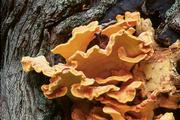 Cy and Mary Hampson |
72b Pileus not with bright red to orange upper surface and bright yellow tube layer
................................................................................73
73a Pileus context duplex, the upper layer 1-2 cm thick, texture loose, soft cottony
................................................................................Oligoporus leucospongia
| Pileus 1- 5 x 2-10 x 1-2.5 cm, semicircular to elongate, white to cream color, drying with a slight pinkish cast; margin a broad, thick, cottony roll; context below the upper cottony layer 1-1.5 mm thick, tough, dense; tubes 2-6 mm deep; pore surface white to pale buff, often with a pinkish cast; pores 2-3 per mm with lacerate or dentate edges. Basidiospores 4.5-6.0 x l.0-l.5 μm, allantoid; hyphal pegs present; context monomitic with clamps. Color picture figure 526 in Lincoff (1994). Note 40. | Oligoporus leucospongia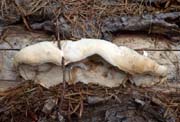 Steve Trudell |
73b Pileus duplex or not, if duplex then lacking a thick, loose, cottony layer
................................................................................74
74a Pileus at first with a thin golden yellow tomentum that soon wears off, revealing the agglutinated, resinous, radially wrinkled, dark brown to blackish brown pileus surface that feels like fine sandpaper
................................................................................Ischnoderma resinosum
| Pileus 3-15 x 7-25 x 1-4 cm, applanate, semicircular to reniform; context tough-fleshy becoming corky, pale beige when young, pale brown when old; tubes 1-10 mm deep; pore surface white to pallid, staining brown to fuscous where bruised, dark brown when old; pores 4-6 per mm, round to angular. Basidiospores 4-7 x 1.5-2 μm, cylindrical or allantoid; context dimitic; generatives thin- to thick-walled, with clamps; skeletals thick-walled, unbranched. Color picture figure 525 in Lincoff (1994). Note 41. | Ischnoderma resinosum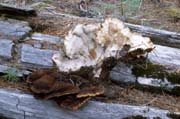 Steve Trudell |
74b Pileus surface not dark brown to fuscous, not agglutinated-resinous, radially wrinkled and not feeling like fine sandpaper
................................................................................75
75a Pore layer gelatinous, elastic, pulling away in its entirety from the pileus; context flesh color to pale reddish purple to purplish black (raisin color)
................................................................................Gloeoporus dichrous
Basidiocarps often effuse-reflexed; pileus 0.5-4 x 1-8 x 0.1-0.5 cm, conchate, often imbricate, often confluent, whitish to pale ochraceous, surface tomentose to matted tomentose to velvety, becoming glabrous in age; margin sterile for 1 mm or so on its under surface; context 1-4 mm thick, white, leathery-tough; tubes 1 mm or less deep; pore surface pale buff to vinaceous purple or raisin-black; pores 5-8 per mm.
Basidiospores 3-4.5 x 0.5-1.0 μm, allantoid; context monomitic, gelatinized only in a thin layer just above the tubes; generatives with clamps. Note 42.
75b Hymenophore not gelatinized, not separating from the pileus context in fresh specimens; color varying
................................................................................76
76a Pores variable in outline, occasionally round, more frequently angular, radially elongated or labyrinthiform; pileus rigid, corky, thin, applanate, the surface glabrous, rugose
................................................................................Daedaleopsis confragosa
| Pileus 2-10 x 3-15 x 0.5-3 cm, sometimes imbricate, rarely effuse-reflexed, gray to beige to brown or umber or fuscous or nearly black; context 0.5-2 mm thick, white to beige, leathery when fresh, drying corky-rigid and hard; tubes 10-15 mm deep; pore surface whitish to beige to pale brown, darkening with age; pores 0.5-1.5 mm diam. Basidiospores 7-9 (-11) x 2-2.5 μm, cylindrical; cystidia-like thick-walled, hyaline, dendroid hyphae extend into the hymenium; context trimitic; generatives with clamps, skeletals unbranched; binding hyphae abundantly branched, thick-walled to solid. Color picture figure 481 in Lincoff (1994). Note 43. | Daedaleopsis confragosa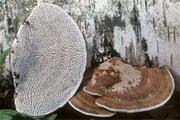 Boleslaw Kuznik |
76b Pores variable but not to the extremes indicated in the above entry; pileus surface and texture of context varying
................................................................................77
77a Tube layer and pore surface gray to black
................................................................................Bjerkandera adusta
| Basidiocarps sometimes effuse-reflexed; pileus 1-6 x 3-10 x 0.1-0.8 cm, often imbricate, white to pale gray or pale tan, finely tomentose to suede-like to glabrous; context 1-8 mm thick, white, fibrous, tough; tubes 1-2 mm deep; pores 5-7 per mm, round to angular. Basidiospores 3.5-5.5 x 2-3 μm, oblong-ellipsoid; context monomitic; generatives moderately thick-walled, with clamps. Color picture figure 582 Lincoff (1994). Note 44. | Bjerkandera adusta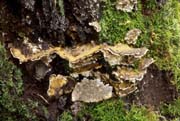 Steve Trudell |
77b Tube layer and pore surface not gray to black
................................................................................78
78a Basidiocarps white, turning red to brownish red where bruised or handled, and drying red or red-brown
................................................................................79
78b Basidiocarps varying in color when fresh, but not staining red to red-brown where bruised, or drying red to red-brown
................................................................................81
79a Pores 1-3 per mm; context 2 mm or more thick
................................................................................80
79b Pores 3-5 per mm; context up to 1 mm thick
................................................................................Oligoporus fragilis
| Basidiocarps effuse-reflexed or sessile; pileus 4 x 7 x 1.5 cm, convex, semicircular, soft and fleshy, drying rigid but fragile, surface finely tomentose to glabrous, white, bruising red; context up to 1 cm thick, white; tubes up to 7 mm deep; pore surface white, bruising red; pores 3-5 per mm, round to angular. Basidiospores 4.5-5.5 x 1.5-2.5 μm, allantoid; context monomitic; generatives with abundant clamps. Color picture figure 589 in Lincoff (1994). Note 45. | Oligoporus fragilis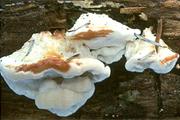 Boleslaw Kuznik |
80a Pileus surface tomentose when fresh, drying short-hispid and rough
................................................................................Amylocystis lapponica
Basidiocarps effuse-reflexed or sessile; pileus 5 x 10 x 2.5 cm, applanate to convex, dimidiate to conchate, white, becoming red where bruised; context up to 2 cm thick; tubes up to 7 mm deep; pore surface white, staining red; pores 1-3 per mm, round, angular or undulating.
Basidiospores 8-10 x 2.5-3.5 μm, cylindrical; metuloids 20-35 x 5-7 μm, amyloid, sometimes crystal-capped; context monomitic; generatives with frequent clamps. Note 45.
80b Pileus surface sparsely tomentose when fresh, drying glabrous and smooth
................................................................................Leptoporus mollis
| Pileus solitary or imbricate, 6 x 9 x 4 cm, semicircular to elongated, triquetrous in section; context up to 2 cm thick, white, staining red, fleshy-tough, drying soft, corky; tubes 3-10 mm deep; pore surface white, pink when old, staining red where handled, drying red; pores 3-4 per mm, angular to elongated. Basidiospores 4-6 x 1.5-2 μm, allantoid; context monomitic; generatives lack clamps. Note 45. | Leptoporus mollis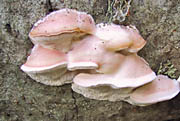 May Kald |
81a (78) Pileus surface shiny, appearing as though covered with varnish or lacquer
................................................................................Ganoderma oregonense
| Pileus 5-28 (-80) x 5-40 (-100) x 2-10 (-20) cm, semicircular to conchate or reniform, red-brown or mahogany, lighter at margin when growing; surface smooth, glabrous, shining unless dusted with spores; context thick (2-8 cm), white to straw color, soft and punky; tubes 1-2 cm deep, brown; pore surface pallid, darkening to brown in age; pores round, 2-3 per mm. Basidiospores 10-16 x 7-9 μm, ovoid the apex truncate, walls thick, brown with internal ornamentation; context trimitic; generatives with clamps, skeletals hyaline, unbranched; binding hyphae dendroid. Note 46. | Ganoderma oregonense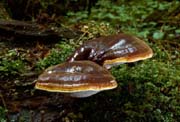 Steve Trudell |
81b Pileus surface not with a shining, varnish-like crust
................................................................................82
82a Pileus and pore surfaces with blue mottling or streaks, staining pale blue were bruised; spore print gray-blue
................................................................................Oligoporus caesius
| Pileus up to 5 x 6 x 1.5 cm (usually half that size), semicircular to conchate or reniform, white to grayish white with blue tinges, surface minutely velutinous, becoming glabrous; margin gray-blue; context up to 1 cm thick, white, soft and watery fresh, firm and friable dry; tubes 2-8 mm deep; pore surface white to pale grayish or pale grayish blue; pores 3-4 per mm, angular. Basidiospores 3-5 (-6) x 1-1.5 μm, allantoid; context monomitic; generatives thick-walled, weakly amyloid, with clamps. Color picture figure 522 in Lincoff (1994). Note 47. | Oligoporus caesius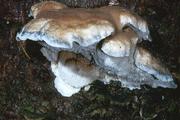 Michael Beug |
82b Basidiocarp neither blue nor staining blue; spore print usually white or cream, not blue gray
................................................................................83
83a Basidiocarps effuse-reflexed
................................................................................84
83b Basidiocarps pileate-sessile
................................................................................87
84a Pileus surface densely hirsute, tomentose or velutinous, zonate; context fibrous-pliable
................................................................................85
84b Pileus surface not densely hirsute and zonate, at most minutely velutinate or fibrillose; context corky, tough
................................................................................86
85a Pileus surface with all the zones hirsute to tomentose, all the same color
................................................................................Trametes hirsuta (see # 88a)
85b Pileus surface with alternating appressed-silky glabrous zones and densely hirsute zones, the silky zone varying in color (orange, red-brown, etc.), tomentose zones dingy whitish to pale grayish beige
................................................................................Trametes versicolor (see # 88b)
86a (84) Pileus surface white or cream color, rarely tinged with pale brown; pores large, 1-2 mm in diameter
................................................................................Antrodia heteromorpha (see # 60b)
86b Pileus surface usually brown, rarely cream color; pores small, 2-5 per mm
................................................................................Antrodia serialis (see # 59a)
87a (83) Pileus densely hirsute or tomentose or velutinous, zonate; context fibrous-pliable
................................................................................88
87b Pileus not densely hirsute and zonate, at most minutely velutinate or fibrillose; context corky, tough, or very hard and dense
................................................................................89
88a Pileus surface with all the zones hirsute or tomentose, all the same color
................................................................................Trametes hirsuta
| Pileus 1.5-6 x 1.5-10 x 0.5-1.0 cm, semicircular to conchate or reniform, gray or dingy yellowish, darkening with age to dingy straw color to pale brown, sometimes weathering or bleaching white; margin usually brown; context 1-6 mm thick, white, tough-fibrous; tubes 1-4 mm deep; pore surface white, dingy yellowish or gray; pores 3-4 per mm, round to angular. Basidiospores 5-7 x 2-2.5 μm, allantoid; context trimitic; generatives thin-walled with clamps; skeletals hyaline, thick-walled, unbranched; binding hyphae intricately and irregularly branched. Note 48. | Trametes hirsuta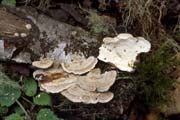 Steve Trudell |
88b Pileus surface with alternating appressed-silky to glabrous zones and densely hirsute zones; the silky zones varying in color (orange, red-brown, greenish brown, etc.); the tomentose, hirsute zones dingy whitish to pale grayish beige
................................................................................Trametes versicolor
| Pileus 2-5 (-7) x 2-7 (-10) x 0.3-0.5 cm, semicircular or conchate or reniform; context tough-pliable, fibrous, about 1-2 mm thick, white; tubes 2 mm deep; pore surface white to cream color; pores 3-5 per mm, round. Basidiospores 4-6 x 1.5.2 μm, cylindrical to allantoid; context trimitic; generatives with clamps; skeletals thick-walled, hyaline, unbranched; binding hyphae slender, intricately and irregularly branched. Color picture figure 482 Lincoff (1994). Note 49. | Trametes versicolor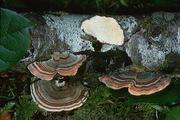 Michael Beug |
89a (87) Context when fresh very dense, hard, tough-fleshy; drying bone-hard
................................................................................Oligoporus obductus
| Basidiocarps variable, eccentric to laterally stipitate or sessile, stem about 1-3 cm long, 3-6 mm thick, very hard, glabrous, tapering downward, white; pileus usually narrowed toward the point of attachment, spathulate, fan-shaped, conchate or subreniform; surface smooth, glabrous, white, dingy ivory, cream color or dingy beige; context 3-10 mm thick, white; tubes 1-3 mm deep; pore surface white to cream; pores 3-5 per mm, round to angular. Basidiospores 4-6 x 2-3 μm, cylindric-oblong; context monomitic; generatives with clamps, very thick-walled, very tightly and intricately interwoven, very difficult to separate, walls more or less gelatinized. Color picture figure 461 in Lincoff (1994). Note 50. | Oligoporus obductus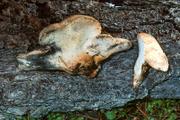 Michael Beug |
89b Context soft-fleshy to firm-fleshy or fibrous, drying rigid, but never bone-hard
................................................................................90
90a Context taste bitter to very bitter
................................................................................91
90b Context taste not bitter, may be mild, fungoid, rather resinous or disagreeable, etc.
................................................................................92
91a Pileus surface exuding drops of liquid that upon drying leave small scrobiculate spots; taste (dried) at first somewhat acrid, then becoming bitter
................................................................................Oligoporus guttulatus
| Pileus 3-12 x 5-15 x 0.5-1.5 cm, thin and applanate, often narrowed to the point of attachment and wedge-shaped, otherwise spathulate, fan-shaped, conchate or semicircular; surface glabrous to slightly hispid, zonate, white to ivory, often with a subtle greenish cast (not green !); context 5-10 mm thick, white, brittle-fleshy, with pleasant resinous odor; tubes 1-5 (-10) mm deep; pore surface white to pallid yellowish, often with faint greenish cast; pores 4-5 per mm, round becoming angular. Basidiospores 4-6 x 2-3 μm, oblong; hyphal pegs present; context monomitic; generatives with clamps; gloeopleurous hyphae present. Note 51. | Oligoporus guttulatus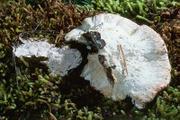 Michael Beug |
91b Pileus surface not exuding drops of liquid, hence not scrobiculate, but instead agglutinated-tomentose drying rough, hispid; taste immediately very bitter
................................................................................Oligoporus stipticus
Pileus 1.5-8 x 2-15 x 0.5-2.5 cm, white, semicircular or reniform; context 5-15 mm thick, white, cheesy-watery; tubes 2-12 mm deep; pore surface white, drying yellowish; pores 4-6 per mm, angular.
Basidiospores 4-5.5 x 1.5-2 μm, cylindrical; hyphal pegs present; context dimitic; generatives with clamps. Note 51.
92a (90) Pileus surface zonate, exuding drops of liquid that form scrobiculate spots on drying
................................................................................Oligoporus guttulatus (see # 91a).
92b Pileus surface azonate, not exuding drops of liquid, hence not scrobiculate
................................................................................Tyromyces chioneus
| Pileus 2-7 x 1-12 x 0.5-3.0 cm, convex, semicircular, surface white, finely tomentose to glabrous, drying yellowish or grayish; context 2-15 mm thick, white, soft and watery when fresh, drying friable; tubes 1.5-5 (-7) mm deep; pore surface white to cream; pores 4-5(-6) per mm, round to angular. Basidiospores 3-5 x 1-2 μm, allantoid; hyphal pegs uncommon, scattered; context monomitic; tube trama dimitic; generatives with clamps, thick-walled, much branched; skeletals slender; gloeopleurous hyphae present. Color picture figure 490 in Lincoff (1994). Note 51. | Tyromyces chioneus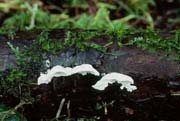 Michael Beug |
(1) Fomitopsis cajanderi (Rosy Conk) Basidiocarps grow on stumps or logs or parts of living conifers, especially Douglas-fir and Ponderosa pine. The similar F. rosea differs in its typically ungulate and sessile basidiocarps, typical occurrence in spruce forests at higher elevations, and straight basidiospores, 2-2.5 μm wide.
(2) Pyrofomes demidoffii (Juniper Conk) The rusty orange context that turns red with KOH, the round, thickwalled, yellow pores, and occurrence only on trunks of living juniper trees, make this an easily recognized polypore. It is more frequent east of the Cascade Mts. than to the west, because its host tree grows principally in that area. It has been known to foresters as Fomes juniperinus but the species name demidoffii dates from 1842, whereas juniperinus was proposed 60 years later.
(3) Ganoderma applanatum (Artist's Conk) The crusted, applanate pilei often reach dimensions much larger than those given in the description, and are often dusty with brown spores. The white pore surface that instantly turns brown where touched, enables the artist to draw a permanent picture, thus the common name. Basidiocarps grow on large slash of both conifers and hardwoods, and the fungus is one of the most active slash disposal polypores in the region.
(4) Phellinus ferruginosus A common slash-inhabiting polypore, primarily on hardwoods. The similar P. ferreus differs in having larger (5-8 x 2-2.5 μm) basidiospores and lacking setal hyphae in the margin of the basidiocarp. Phellinus ferrugineofuscus has a bright yellowish brown context, setal hyphae that bend abruptly and project into the tubes and cylindrical basidiospores, 4-5.5 x 1-1.5 μm.
(5) Phellinus pini (Pine Conk) The basidiocarps are characterized by the concentrically grooved, hispid pileus surface that feels like coarse sandpaper, and the brown, variably shaped pores, i.e., often labyrinthiform. Older tube layers become more or less filled with rusty brown hyphae, tending to obscure the distinction between annual layers. Typically growing on living conifers. Phellinus pini is not a slash rot, and will produce basidiocarps on logs or stumps only if it was already present in the trunk when the tree was still alive. It is seldom found on trees less than 40 or 50 years old. The similar P. chrysoloma has effuse, reflexed or sessile, often imbricate, thinner (up to 3 cm thick) basidiocarps and setae only 7-10 μm in diameter.
(6) Phellinus igniarius (False Tinder Conk) On hardwoods, mostly on alder, maple, and willow. Very young basidiocarps and rarely older ones may have the pileus surface smooth and gray. Those somewhat resemble Fomes fomentarius conks. Macroscopically the paler brown context of F. fomentarius lacks the white streaks that are in the dark brown context of P. igniarius. Microscopically the distinction is more clear-cut; P. igniarius has setae and basidiospores 5-7 μm long, whereas F. fomentarius lacks setae and has basidiospores 17-20 μm long.
(7) Fomes fomentarius (Tinder Conk) Basidiocarps smooth, gray, ungulate; context seemingly unstratified, basidiospores are among the largest in the polypores. The reason for the seeming lack of stratification is that the current tubes at the end of their season's spore production are not filled up with hyphae as usually is the case with perennial polypores, but instead all the tubes simply elongate to form the next season's tube layer, without much (if any) indication of where one layer leaves off and the next begins. Thus, any one tube is continuous from the pileus context to the current season's spore surface, and the context resembles a collection of parallel, long capillary tubes: such a substance would soak up liquids by capillary action. In the days before the invention of matches, pieces of F. fomentarius context were soaked in saltpeter solution until saturated, then dried carefully to form tinder, which would burst into flame when a spark was dropped on it.
(8) Bridgeoporus nobilissimus (The Fuzzy Sandozy) The dense, thick, stiff, doormat-like pileus surface layer, and the conspicuously stratified tube layers, each separated by a white mycelial layer, distinguish B. nobilissimus. It is found in western Oregon and Washington, and principally on large stumps of Noble Fir. Old basidiocarps are among the largest of the polypores, equaled or exceeded in size only by an occasional old Ganoderma applanatum, Fomitopsis pinicola or F. officinalis.
(9) Fomitopsis officinalis (Quinine Conk) The chalky, friable context has a bitter taste due to large amounts of crystalline and amorphous substances. Because of the taste, the context was thought to have the same antimalarial properties as quinine, in fact it is merely mildly poisonous. These imagined medicinal qualities gave it the common name. Decades ago the large (up to a meter tall) cylindrical conks high on the trunks were harvested by shooting them off the tree, then sold for their so-called medicinal value. The basidiocarps occur in two forms, ungulate and cylindrical. The former is the one usually found on large conifer slash, and the latter is usually seen high up on the trunk of a living tree. The presence of one conk between 20 and 40 feet from the ground means that about half of the heartwood has been decayed, and the presence of two (or more) conks means that the entire heartwood has been destroyed.
(10) Fomitopsis pinicola (Red Belt Conk) A common polypore on dead conifers; rarely fruiting on dead hardwood trees. It occurs on living trees only if there is a wound extensive enough to expose the heartwood. The red band at the margin is typical of young basidiocarps and may not be obvious on aged basidiocarp. The basidiocarps might be confused with those of Heterobasidion annosum (see comparison in Note 11). On large conifer slash the basidiocarps of F. pinicola can grow to considerable size; one at U. Washington measures 35.5 x 75 x 20 cm.
(11) Heterobasidion annosum (Annosus Root Rot) The brown to black, wrinkled pileus and cream colored margin and pores distinguish H. annosum. Parasitic on the roots of living trees; it also causes a butt rot. It fruits on the lower surface of logs or partially hidden in the needle layer at the base of live and dead trees and stumps. Heterobasidion annosum can be a very destructive fungus in second-growth forests, particularly of Western Hemlock. By decaying the roots it predisposes the tree to windfall, and not infrequently kills young trees outright.
(12) Pycnoporus cinnabarinus (Cinnabar-red Polypore) Infrequent in our region; fruiting on hardwood logs often in sunny openings in the forest. It is easily identified by the red colors, especially the bright red tube layer.
(13) Pycnoporellus alboluteus (Orange Sponge Polypore) The large, irregular orange tubes with jagged white edges tending to become irpiciform and the orange context turning red with KOH are distinctive features. Basidiocarps are usually effuse patches, sometimes effused-reflexed, and rarely forming a true pileus. Typically growing on the lower surface of conifer logs, sometimes on large fallen branches.
(14) Pycnoporellus fulgens Not frequently collected. Basidiocarps appear while there are still a few patches of snow in the forests and grow on conifer logs and slash at elevations of 3000 feet and above. Its distinguishing features are the soft, fibrillose, orange pileus and the thin, irregular edges of the tubes that tend to split, giving the appearance of an irpiciform hymenophore. The context stains red in KOH but the color quickly darkens to black. The soft basidiocarps are short-lived being destroyed by beetles.
(15) Lenzites betulina (Multicolor Gill Polypore) The pileus surface looks so much like that of Trametes hirsuta that it is surprising to find lamellae instead of pores on the lower surface. The microscopic characteristics are essentially the same in both species. Lenzites betulina is not uncommon, growing on several kinds of hardwoods, with a preference for willow.
(16) Gloeophyllum sepiarium (Yellow-red Gill Polypore) The brown context and tough, leathery lamellae characterize this species. Most of the other species of Gloeophyllum are poroid. This is one of the first fungi to colonize slash on recently logged-off conifer forests. And it commonly grows on wooden decks and porch railings, untreated telephone poles, railroad ties, and mine timbers.
(17) Piptoporus betulinus (Birch Polypore) Confined to dead birch, P. betulinus is not common in our region because of the limited distribution of its host. It is a handsome polypore, unmistakably characterized by the recessed pore surface surrounded by the curb-like projecting margin of the pileus, the thick, corky context, and convex surface of the pileus covered by a paper-thin pellicle. The pileus, when viewed from above, is circular to reniform in outline, and fastened to the wood by a thick, tough, lateral stub which has been referred to as a pseudostipe.
(18) Phaeolus schweinitzii (Dyer's Conk) A relatively common polypore that causes a destructive heartrot of the butt of large, live conifers. Basidiocarps that develop on the ground are actually connected to the roots of the infected tree, and they often form a rosette or grow as a single stipitate pileus. When growing on logs, stumps, snags, it forms an applanate, sessile pileus. The soft, brittle context, greenish tubes that quickly turn brown where bruised, and the long, cylindrical leptocystidia are distinctive features. Small basidiocarps might be confused with those of Inonotus tomentosus, another terrestrial brown polypore, but the soft, velvety pileus surface of the latter is quite different from the rather harsh, hispid surface of P. schweinitzii. Microscopically the setae of I. tomentosus are quite different from the leptocystidia of P. schweinitzii.
(19) Inonotus tomentosus (Woolly Velvet Polypore) and I. circinatus Both have a duplex (two layered) context, giving a very soft feel to the pileus surface, gray to beige pore surface with small round pores, and setae in the hymenium. They differ in growth habit and shape of setae; I. tomentosus is stipitate and terrestrial, with straight setae, whereas I. circinatus is sessile and applanate or triquetrous, with the tip of the setae hooked (circinate). Although its descriptive entry in the key mentions a rosette growth habit, I. tomentosus is typically stipitate with a single pileus; if several pilei grow together they are said to be confluent.
(20) Bondarzewia montana (Bondarzew's Polypore) The reports of B. berkeleyi (Berkeley's Polypore) on conifers in the northwest are now thought to have been based upon misidentifications. Gilbertson and Ryvarden (1986) concluded that if it was in the west it was rare.
(21) Coltricia perennis One of a few polypores that are ectomycorrhizal, its basidiocarps are stipitate, small to medium sized with thin, brown context and commonly occur on sandy soil along paths and lanes or in open places in the forest. The circular, silky, brown, concentrically zonate pilei and brown tubes distinguish the species. The pileus fades to gray when weathered. Because of the color and terrestrial stipitate habit, C. perennis might be confused with Inonotus tomentosus but that species has much larger and thicker basidiocarps, and C. perennis lacks setae. The smaller, brighter red-brown, satiny-shiny C. cinnamomea occurs here but is rare.
(22) Jahnoporus hirtus (Bitter Iodine Polypore) The unique iodine odor, brown hispid pileus, and large, boletoid basidiospores are its chief distinguishing features. The odor becomes perceptible and often quite strong after the specimen has been removed from its substratum for several minutes. The odor is absent in dried specimens. Jahnoporus hirtus is a common species in our region.
(23) Albatrellus ellisii (Greening Goat's Foot) and A. pes-caprae (Goat's Foot) Structurally, these two are very similar; both have large, thick-fleshed pilei with a densely revolute-scaly surface, an excentric to lateral, stout stipe, and large pores of irregular shape. The green staining reaction of A. ellisii distinguishes it and is almost unique in the polypores. Pileus color and a slight difference in basidiospore size distinguish the two. Albatrellus ellisii is the more common species in our region.
(24) Albatrellus ovinus (Sheep Polypore) and A. flettii (Flett's Polypore) Although similar in habitat, size, and general appearance, A. ovinus has a white to ivory colored pileus, whereas A. flettii has a grayish blue pileus that fades (on exposure to sunlight?) leaving the pileus pinkish buff to pale orange-brown. Albatrellus confluens is pinkish buff but lacks any blue tints. Old basidiocarps of A. flettii and A. confluens are indistinguishable. Since the microscopic features of A. flettii and A. confluens are identical it may be that reports of A. confluens from the PNW were base upon old specimens of A. flettii. Two other species of Albatrellus have basidiocarps that resemble those of A. ovinus. Albatrellus avellaneus is initially white and develops obvious yellow tints, prefers the Pacific coast under hemlock and spruce, fruits in the late autumn and has basidiospores 5-5.6 x 3.6-4.2 μm, larger and not overlapping the basidiospore sizes in A. ovinus. Albatrellus subrubescens is like A. ovinus but has amyloid basidiospores.
(25) Boletopsis subsquamosa (Kurotake) The gray to black colors, terrestrial habitat, and stout basidiocarps with a thick white context make it easy to recognize. However, it has been mistaken for a bolete. It is very bitter but prolonged soaking with frequent change of water make basidiocarps palatable. A Boletopsis having a dull orange pileus with tints of gray would be B. smithii, a species known from a few western Washington collections.
(26) Polyporus squamosus (Dryad's Saddle) Easily recognized by its large, thick-fleshed, tough pileus with coarse, appressed, dark scales on a pale yellow background color, thick, black stipe, and large (1-2 per mm), angular pores. The large basidiospores help to separate it from other polypores with radiating angular pores. It is found occasionally in our region.
(27) Polyporus arcularius (Spring Polypore) and P. brumalis (Winter Polypore) The radially aligned, hexagonal pores, centrally depressed, centrally stipitate, thin, tough basidiocarps, distinguish these two from other polypores. Polyporus brumalis differs from P. arcularius by its much darker pileus, the lack of a fringe of hairs around the pileus margin, and especially by its smaller spores. Polyporus brumalis has the pore shape angular and less strikingly hexagonal. For that reason it is cross referenced to the key entries for the Melanopus complex (see Note 28). Specimens lacking hexagonal pores will have the typical glabrous, straw color to dark brown or bronze to purplish brown stipe to distinguish it from the black-stemmed species of the the Melanopus complex.
(28) Polyporus elegans, P. varius (Elegant Polypore) and P. badius (Black-Footed Polypore) These three are part of the Melanopus complex that is characterized by species having a black, minutely velvety stem (the velvet may wear off with age but the stem is still black). Polyporus elegans is characterized by its light colored pileus that lacks radial striations, basidiospores 7.5-10 x 2.5-3 μm, and pores that are 5-7 per mm. Polyporus varius has the pileus intermediate in color between P. elegans and P. badius, and often strikingly radially streaked with lighter colors, and relatively large basidiospores, 9-12 x 2.5-3 μm. The dark pileus color (chestnut to almost black) of P. badius distinguishes it from the other two species. One diagnostic feature of the genus Polyporus is a dimitic hyphal system with dendritic binding hyphae, but P. badius is the exception because it is trimitic. Typical specimens can be recognized by these salient features, but unfortunately there seems to be considerable variation in the features themselves, making the naming of collections difficult and perplexing. (Stuntz).
(29) Cryptoporus volvatus (Veiled Polypore) Basidiocarps form in the spring and the young ones have a shiny, thin, varnish-like surface. This surface layer is short-lived as it dries, cracks and sloughs off. The tubes are hidden by a leathery membrane that is perforated by a single hole next to the bark. Beetles are attracted (by odor?) and enter the hole, feast on spores and spores stick to their bodies. The beetles then seek out a recently dead or dying tree in which to construct a brood tunnel, where the basidiospores germinate and grow in the sapwood. The beetles that visit C. volvatus are not attracted to healthy trees, so the fungus is always found on recently dead or dying ones, or on recently cut logs. Fire-killed trees are frequently found with dozens of basidiocarps all up and down the trunk in the spring after their death. Only conifers are invaded.
(30) Gloeophyllum carbonarium Basidiocarps have been found only on charred conifer wood. The allantoid basidiospores, clamps and lack of setae distinguish it from the two Phellinus species (of key entry 51), which it resembles in macroscopic features. Ginns thought this fungus was distinct enough from other Gloeophyllum species to segregate it in the genus Griseoporia.
(31) Junghuhnia nitida The pink to salmon colored pore surface sets it apart from the great mass of white to cream colored Porias. Microscopically the incrusted cystidia are a distinguishing feature; they are usually so numerous that they give a fringed appearance to the edges of the pores as seen with a hand lens. Another pink Poria, J. collabens, in the Northwest is distinguished from J. nitida by its narrow, cylindrical to allantoid basidiospores 4-5(-7) x l.5-2 μm.
(32) Antrodia serialis The core species of Antrodia can usually can be recognized by their tough, corky, white to pale brown basidiocarps with large pores, and large (6-14 μm long), boletoid to cylindrical basidiospores. Antrodia serialis and A. albida have relatively small (2-3 per mm) pores; pores in A. heteromorpha and A. variiformis are 1-2 per mm. Antrodia serialis often grows on the ends of cut logs, from which it is practically impossible to remove except as small pieces. The pale brown basidiocarps distinguish A. variiformis and its basidiospores (8-12 x 3-4.5 μm) are significantly larger than those of A. serialis. On occasion A. serialis becomes reflexed forming a narrow pileus with brown surface.
(33) Perenniporia subacida and Phellinus ferruginosus Two common effuse polypores fruiting on conifer and hardwood slash and stumps. The cream to yellow basidiocarps of P. subacida distinguish it, especially if there is more than one pore layer. Another poroid yellow resupinate, P. medulla-panis is practically impossible to distinguish from P. subacida in the field. Microscopically the basidiospores are ovoid to broadly ellipsoid and the tramal skeletals 2.5-7 μm in diameter in P. subacida, whereas P. medulla-panis has truncated basidiospores and narrower tramal skeletals (2.5-5 μm diameter).
(34) Gloeophyllum odoratum This is our only brown Trametes-like polypore with an anise odor, thus it is easily identified. Haploporus odorus and Trametes suaveolens smell of anise, but both have a white context. Haploporus odorus occurs in central British Columbia but has not been found in the United States.
(35) Coriolopsis gallica and Trametes trogii Both species occur cottonwood stumps and slash. Trametes trogii is paler in color with a white to wood-colored pore surface, and white tubes and context.
(36) Trichaptum abietinum The purplish, irpiciform hymenophore make this common polypore immediately recognizable. The purple colors tend to fade with age and in drying, but even then the small, thin, soft white pilei and occurrence on conifers strongly suggest T. abietinum. It is one of the few wood-inhabiting Hymenomycetes whose decay activities are essentially confined to the sapwood. Trichaptum biforme is similar but grows on hardwoods.
(37) Cerrena unicolor (Mossy Maze Polypore) The pileus surface resembles Trametes versicolor, but the characteristic gray, irpiciform hymenophore of C. unicolor distinguishes it. The black line separating the surface tomentum from the underlying context is not always obvious. However, its presence is not critical; there is no other polypore with the combination of hirsute, zonate pileus surface and gray irpiciform hymenophore. Bjerkandera adusta also has a gray hymenophore but it is poroid, and its pileus surface is suede-like and not zonate.
(38) Irpex lacteus (Milk-white Toothed Polypore) The toothed (irpiciform) hymenophore, the lack of clamps and the crystal incrusted metuloids in the hymenium distinguish it from other polypores, including a Trichaptum that has lost the violet color. The Trichaptum metuloids are much smaller and only capped with crystals, not incrusted.
(39) Laetiporus conifericola (Western Chicken Polypore) Collections named L. sulphureus have been, beginning about 1998, segregated into distinct groups. Two of these groups occur in the Pacific Northwest and have been named L. conifericola and L. gilbertsonii. The basidiocarps of L. conifericola grow on large, living and dead conifers and are more common than those of L. gilbertsonii which is known in the PNW from two collections, in Oregon on Garry oak and Washington on Prunus sp.
(40) Oligoporus leucospongia (Marshmallow Polypore) Its thick, soft, cottony (marshmallow-like) pileus context is unique, and gave rise to the common name. The actual pileus surface is a thin, papery, fragile membrane that keeps the cotton in place. The basidiocarps are not often collected because of their habitat, on conifer slash at higher altitudes usually near receding snow banks.
(41) Ischnoderma resinosum (Resinous Polypore) The distinctive (and unique) feature of this polypore is its very dark brown, radially wrinkled pileus surface that feels like fine sandpaper. The texture of the pileus surface is caused by a brown resinous substance that binds the hyphae of the pileus surface together, and solidifies. The pileus surface is dark colored from the outset, but the tubes and context are beige or paler at first, and darken to brown with age, the pore surface also staining brown where bruised. In the autumn some basidiocarps and rotting wood give off a distinct anise odor than can be detected 5 m away. In our region I. resinosum seems to prefer large conifer logs, and consequently is most apt to be found in older conifer forests.
(42) Gloeoporus dichrous (Gelatinous-pored Polypore) When fresh the gelatinized pore layer peels off in a single elastic layer; it dries rigid and brittle. The pinkish buff to blackish purple color of the pore layer is also distinctive. Specimens with the darker tube layer may be mistaken for Bjerkandera adusta but its pore layer is not gelatinized and is inseparable from the pileus context. The basidiospores in G. dichrous are allantoid and in B. adusta they are oblong-ellipsoid. A similar appearing polypore, Skeletocutis amorpha, has a gelatinized pore layer but it is reddish orange and the pores are small (6-8 per mm versus 4-6 per mm in G. dichrous).
(43) Daedaleopsis confragosa (Thin-maze Flat Polypore) An extremely variable polypore, especially in size and shape of pores that may be round and regular to angular, labyrinthiform, radially elongated, and the hymenophore may even be irpiciform (key entry 69) or lamellate (key entry 21). The colors vary also; typically the pileus is some shade of gray-brown, but gray or almost black specimens occur. Occasionally a light colored young specimen in growing condition will stain dull vinaceous red where bruised. One learns to recognize this polypore principally by its thin, corky-rigid, applanate pileus with glabrous, rugose, concentrically zoned surface. It seems especially partial to willow, but grows on other hardwoods.
(44) Bjerkandera adusta (Smoky Polypore) Typically fruits in large, imbricate masses on hardwood stumps. Bjerkandera fumosa occurs here but is infrequently collected. It differs from B. adusta in having a buff to pale smoky gray pore surface and a relatively thick context with a dark line at the base of the tubes.
(45) Oligoporus fragilis (Staining Cheese Polypore), Leptoporus mollis and Amylocystis lapponica. The descriptions of these three polypores are similar. The basidiocarps are white, pileate and stain reddish brown when bruised or on drying. Collections can be named when a few microscopic characteristics (see below) are evaluated.
|
NAME |
SPORE SIZES & SHAPE |
CLAMPS |
CYSTIDIA |
|
Amylocystis lapponica |
8-11 x 2.5-3.5 μm, cylindrical |
yes |
amyloid metuloids |
|
Leptoporus mollis |
5-6 x 1.5-2 μm, allantoid |
none |
none |
|
Oligoporus fragilis |
4-5 x 1-1.5 μm, allantoid |
yes |
none |
(46) Ganoderma oregonense (Western Varnish Shelf) Basidiocarps grow on large logs, stumps and snags of conifers and rank with those of Laetiporus conifericola in eye-catching qualities and ease of recognition. The shining, varnish-like crust on the pileus is typical of G. oregonense, G. lucidum (Ling Chih) and G. tsugae (Hemlock Varnish Shelf). Ganoderma lucidum is restricted to hardwoods and occurs in the Pacific Northwest, although Gilbertson and Ryvarden (1986) did not know it from this area. Ganoderma oregonense and G. tsugae may be names for the same fungus (Gilbertson and Ryvarden 1986, Moncalvo et al. 1995). Nevertheless, Gilbertson and Ryvarden distinguished them on the features listed in the table, below. Very young specimens of Fomitopsis pinicola may be more or less completely varnished but the varnish disappears as the basidiocarp ages. The very dense, hard context of F. pinicola is very different from the light, soft-punky context of G. oregonense.
|
NAME |
BASIDIOCARPS UP TO (cm) |
PORES (per mm) |
BASIDIOSPORES ( μm) |
|
G. oregonense |
100 x 40 x 20 |
2-3 |
13-17 x 8-10 |
|
G. tsugae |
20 x 30 x 7 |
5-6 |
13-15 x 7.5-8.5 |
(47) Oligoporus caesius (Blue Cheese Polypore) The basidiocarps are small, soft with blue mottling or bruising blue and the grayish blue spore print is unique. It is rather common on all kinds of slash.
(48) Trametes hirsuta (Hairy Turkey Tail) Basidiocarps are recognized by the thin, applanate, tough, hirsute, zonate pilei. Fresh specimens have a pleasant anise odor. Very young basidiocarps are white; older specimens usually are some shade of gray or beige, and the marginal zone is frequently yellowish brown. On hardwood slash this is one of the common annual polypores; it rarely is found on conifers. Living fruit trees (of any kind) with a pruning scar or wound that exposes the wood often become infected. It causes a white rot of the wood. The hirsute pileus surface when green has been invaded by algae. For a comparison of T. hirsuta with T. versicolor, see Note 49.
|
NAME |
ZONATION |
HYMENOPHORE |
BASIDIOSPORES |
CYSTIDIA |
|
Cerrena unicolor |
hirsute, sulcate, gray to pale brown |
daedaleoid, gray |
5-7 x 2.5-4 μm, oval |
none |
|
Lenzites betulina |
hirsute, concentrically zonate, gray to cream color |
lamellae up to 12 mm deep, cream to ochraceous |
5-6 x 2-3 μm, cylindrical to suballantoid |
none but binding hyphae may resemble cystidia |
|
Trametes hirsuta |
hirsute, zonate, gray |
poroid, white, tan or cinereous |
6-9 x 2-2.5 μm, suballantoid |
none |
|
Trametes versicolor |
alternating silky-glabrous and hirsute |
poroid, white to cream |
5-6 x 1.5-2 μm, cylindrical or allantoid |
none |
|
Trichaptum abietinum |
hirsute, azonate, gray |
poroid to irpiciform, lavender to purple |
6-7.5 x 2.5-3 μm, cylindric or suballantoid |
metuloids, 14-30 x 4-7 μm, crystal-capped |
(49) Trametes versicolor (Turkey Tails) One of the commonest and most abundant polypores of our region. It often grows in large, imbricate masses on hardwood stumps and logs. The basidiocarps are easy to recognize, with their thin, tough, semicircular to conchate or reniform pilei with conspicuously zonate and multicolored surface, and white to pale cream pores. Normally the alternating hirsute and silky zones are of approximately equal size and number, but occasionally the hirsute zones become very wide and the silky ones few and narrow, and then there may be some confusion with T. hirsuta. The color of the glabrous silky zones varies from one collection to another; they may be pale brown, orange-brown, red-brown, umber, or in rare cases, grayish blue. Trametes versicolor is one of the best polypores to use for demonstrating the appearance of typical skeletal hyphae and typical binding hyphae; to observe them pull out a small tuft of pileus context and mount it in KOH and phloxine. The generatives are harder to find, but are readily recognized because they have clamps. There are five polypores in our region with zonate, hirsute pileus and tough, white context. The table above may help in identifying a collection.
(50) Oligoporus obductus (Bone-hard Polypore) The basidiocarps are often laterally stipitate and the surface of the pileus is typically grayish brown, smooth and glabrous. The bone-hard context is easily appreciated once you have seen and handled a dried basidiocarp. No other annual polypore of our region approaches this one in denseness of texture. The thick-walled, partially gelatinized context hyphae are intricately and tightly interwoven, when dried they give the context its extraordinarily hard consistency.
(51) Tyromyces chioneus (White Cheese Polypore), Oligoporus guttulatus and O. stipticus Basidiocarps are white, soft-fleshed, annual and poroid. Basidiocarps of the three species are similar in appearance and their microscopic features are confusingly similar. The zonate, scrobiculate (small (1-3 mm diameter), circular depressions) pileus surface, the exudation of drops of liquid on most fresh basidiocarps, and a faint greenish cast to the pore surface characterizes O. guttulatus. Oligoporus stipticus has a rough pileus that usually has small, black dots on the surface. It grows on both conifers and hardwoods. The separation of T. chioneus from O. guttulatus and O. stipticus is made easy by the bitter taste, fresh or dried, of the Oligoporus species. If the basidiocarp is on a conifer it will not be T. chioneus as that species is restricted to hardwoods. Tyromyces chioneus has a weakly aromatic odor that to me is sweet-spicy with a citrus tinge.
amyloid = cell contents or wall that stain blue in Melzer's Reagent.
applanate = a pileus that is thin, and in vertical section the margin is the apex of an acute angle.
binding = one of the three principal types of hyphae; they are much branched and thick-walled; in Polyporus they are intercalary or terminal, the branches are obviously attenuated to a relatively fine tip and these cells have been labeled skeleto-binding hyphae.
butt rot = a term that foresters (who else would) use to describe rot in the base of a live tree trunk.
clamp connection(s) = a small, arced cell that bridges the septa of generative hyphae.
conk = basidiocarps, particularly those that are large and perennial.
context = the internal tissue of polypores, equivalent to the flesh in agarics.
daedaleoid = pores that are sinuous and lobed, labyrinthine, maze-like.
dendritic = irregularly branched, tree-like.
dextrinoid = cell contents or wall that stain reddish brown in Melzer's Reagent.
dimidiate = semicircular.
dimitic = polypores that form two of the three principal types of hyphae, typically they form generative and skeletal hyphae.
echinulate = covered with slender, acute spines.
effuse = basidiocarps that are entirely attached to the substrate, resupinate, lacking a pileus.
effuse-reflexed = basidiocarps that are more or less effuse but have, at least, part of the margin curving away from the substrate and forming a pileus.
false xanthochroic = having a tan to brown context that stains black when touched with KOH but the black coloration gradually fades
generative(s) = one of the three principal types of hyphae; present in all basidiocarps with clamp connections or simple-septa and thin, hyaline walls; giving rise to skeletal and binding.
gloeopleurous hyphae = having oily, refractive contents that typically stain intensely in phloxine.
hymenophore = that part of the basidiocarp with the hymenium (basidiospore bearing layer), e.g., the pore layer.
hyphal pegs = fascicles of hyphae, peg-like in appearance, that protrude through the hymenium and into the interior of the pores.
irpiciform = resembling teeth or of short ridges or forming irregular spines.
lamprocystidium = a type of cystidium conical in shape with thick walls and typically encrusted.
leptocystidia = thin-walled, lacking incrustations and refractive contents.
monomitic = polypores that form only one of the three principal types of hyphae, the generative hyphae.
pileus = that portion of a basidiocarp with a distinct upper surface and with the hymenophore on the lower surface, for mushrooms the term cap is often preferred.
porias = a common name, based upon the genus Poria, for polypores that form an effuse basidiocarp.
scrobiculate = having numerous small pits or depressions.
sessile = a basidiocarp that is broadly attached to the substrate and lacks a stipe.
setal hyphae = hyphae that have thick, brown walls and a lanceolate, pointed tip; in the polypores they occur in some species of Phellinus and Inonotus.
setae = cystidia-like cells with thick, brown walls and a pointed tip; in the polypores they occur in the hymenium of some species of Phellinus and Inonotus.
skeletals = one of the three principal types of hyphae; typically they lack branches and have thick, hyaline walls.
slash = branches and logs on the ground, especially those left after logging.
subulate = slender tapering to a point, awl-shaped.
trama = mycelium beneath the hymenium, i.e., the tissue that forms the core between the pores or in the teeth.
trimitic = polypores that form the three principal types of hyphae, the generative, binding and skeletal hyphae.
triquetrous = three-angled, the angles usually sharp; basidiocarps that in vertical section are shaped like an acute triangle with the short side abutting the trunk.
ungulate = hoof-like in shape.
xanthochroic = having a reddish- or yellowish-brown context that stains black when touched with KOH (see also false xanthochroic).
| NAME | KEY ENTRIES | NOTE |
| Albatrellus avellaneus Pouzar | 24 | |
| Albatrellus caeruleoporus (Peck) Pouzar | 40b | |
| Albatrellus confluens (Alb. & Schw.):Fr.) Kotl. & Pouzar | 24 | |
| Albatrellus ellisii(Berk.) Pouzar | 37a | 23 |
| Albatrellus flettii Pouzar | 40a | 24 |
| Albatrellus ovinus (Schaeff.:Fr.) Murr. | 39a | 24 |
| Albatrellus pes-caprae (Pers.:Fr.) Pouzar | 37b | 23 |
| Albatrellus subrubescens (Murr.) Pouzar | 24 | |
| Amylocystis lapponica (Romell) Singer | 80a | 45 |
| Antrodia albida (Fr.) Donk | 32 | |
| Antrodia heteromorpha (Fr.) Donk | 60b | 32 |
| Antrodia serialis (Fr.) Donk | 59a | 32 |
| Antrodia variiformis (Peck) Donk | 60a | 32 |
| Bjerkandera adusta (Willd.:Fr.) Karsten | 77a | 37, 42, 44 |
| Bjerkandera fumosa (Pers.:Fr.) Karsten | 44 | |
| Boletopsis smithii Harrison | 25 | |
| Boletopsis subsquamosa (Pers.:Fr.) Kotl. & Pouzar | 41a | 25 |
| Bondarzewia berkeleyi (Fr.) Singer | 28b | 20 |
| Bondarzewia montana (Quélet) Singer | 28a | 20 |
| Bridgeoporus nobilissimus (W.B. Cooke) Volk, Burdsall & Ammirati | 10a | 8 |
| Cerrena unicolor (Bull.:Fr.) Murr. | 69a | 37, 48 |
| Coltricia cinnamomea (Jacq.) Murr. | 21 | |
| Coltricia perennis (Fr.) Murr. | 32a | 21 |
| Coriolopsis gallica (Fr.) Ryv. | 65a | 35 |
| Cryptoporus volvatus (Peck) Shear | 49a | 29 |
| Daedaleopsis confragosa (Bolton:Fr.) Schroeter | 76a | 43 |
| Fomes fomentarius (L.:Fr.) Kickx | 8b | 6, 7 |
| Fomes juniperinus (von Schrenk) Sacc. & Sydow | 2 | |
| Fomitopsis cajanderi (Karsten) Kotl. & Pouzar | 2a | 1 |
| Fomitopsis officinalis (Vill.:Fr.) Bond. & Singer | 11a | 8, 9 |
| Fomitopsis pinicola (Swartz:Fr.) Karsten | 12a | 8, 10, 46 |
| Fomitopsis rosea (Alb. & Schw.:Fr.) Karsten | 1 | |
| Ganoderma applanatum (Pers.) Pat. | 4a | 3, 8 |
| Ganoderma lucidum (W. Curtis:Fr.) Karsten | 46 | |
| Ganoderma oregonense Murr. | 81a | 46 |
| Ganoderma tsugae Murr. | 46 | |
| Gloeophyllum carbonarium (Berk. & Curt.) Ryv. | 52a | 30 |
| Gloeophyllum odoratum (Fr.) Imazeki | 62a | 34 |
| Gloeophyllum sepiarium (Fr.) Karsten | 21a | 16 |
| Gloeoporus dichrous (Fr.) Bres. | 75a | 42 |
| Haploporus odorus (Sommerf.:Fr.) Singer | 34 | |
| Heterobasidion annosum (Fr.) Bref. | 13a | 10, 11 |
| Inonotus circinatus (Fr.) Gilbn. | 64a | 19 |
| Inonotus tomentosus (Fr.) Teng | 26b | 18, 19, 21 |
| Irpex lacteus (Fr.:Fr.) Fr. | 70b | 38 |
| Ischnoderma resinosum (Schrad.:Fr.) Karsten | 74a | 41 |
| Jahnoporus hirtus (Cooke) Nuss | 34a | 22 |
| Junghuhnia collabens (Fr.) Ryv. | 31 | |
| Junghuhnia nitida (Fr.) Ryv. | 57a | 31 |
| Laetiporus conifericola Burds. & Banik | 72a | 39 |
| Laetiporus gilbertsonii Burds. | 39 | |
| Laetiporus sulphureus (Bull.:Fr.) Murr. | 39 | |
| Lenzites betulina (Fr.) Fr. | 20a | 15, 48 |
| Leptoporus mollis (Pers.:Fr.) Pilát | 80b | 45 |
| Oligoporus caesius (Schrader:Fr.) Gilbn. & Ryv. | 82a | 47 |
| Oligoporus fragilis (Fr.) Gilbn. & Ryv. | 79b | 45 |
| Oligoporus guttulatus (Peck) Gilbn. & Ryv. | 91a | 51 |
| Oligoporus leucospongia (Cooke & Harkn.) Gilbn. & Ryv. | 73a | 40 |
| Oligoporus obductus (Berk.) Gilbn. & Ryv. | 89a | 50 |
| Oligoporus stipticus (Pers.:Fr.) Gilbn. & Ryv. | 91b | 51 |
| Perenniporia medulla-panis (Jacq.:Fr.) Donk | 33 | |
| Perenniporia subacida (Peck) Donk | 59b | 33 |
| Phaeolus schweinitzii (Fr.) Pilát | 26a | 18 |
| Phellinus chrysoloma (Fr.) Donk | 5 | |
| Phellinus ferreus (Pers.) Bourdot & Galzin | 4 | |
| Phellinus ferrugineofuscus (Karsten) Bourdot | 4 | |
| Phellinus ferruginosus (Schrader:Fr.) Bourdot & Galzin | 6a | 4, 33 |
| Phellinus igniarius (L.:Fr.) Quélet | 8a | 6 |
| Phellinus pini (Thore:Fr.) A. Ames | 7a | 5 |
| Piptoporus betulinus (Bull.:Fr.) Karsten | 22a | 17 |
| Polyporoletus sublividus Snell | 41b | |
| Polyporus arcularius Batsch:Fr. | 44a | 27 |
| Polyporus badius (Pers.) Schw. | 47a | 28 |
| Polyporus brumalis Pers.:Fr. | 44b | 27 |
| Polyporus elegans Bull.:Fr. | 48a | 28 |
| Polyporus squamosus Hudson:Fr. | 43a | 26 |
| Polyporus varius Fr. | 48b | 28 |
| Pycnoporellus alboluteus (Ellis & Ev.) Kotl. & Pouzar | 17a | 13 |
| Pycnoporellus fulgens (Fr.) Donk | 17b | 14 |
| Pycnoporus cinnabarinus (Jacq.:Fr.) Karsten | 16a | 12 |
| Pyrofomes demidoffii (Lév.) Kotl. & Pouzar | 3a | 2 |
| Skeletocutis amorpha (Fr.) Kotl. & Pouzar | 42 | |
| Trametes hirsuta (Wulfen:Fr.) Pilát | 88a | 15, 48, 49 |
| Trametes suaveolens L.:Fr. | 34 | |
| Trametes trogii Berk. | 65b | 35 |
| Trametes versicolor (L.:Fr.) Pilát | 88b | 37, 48, 49 |
| Trichaptum abietinum (Dickson:Fr.) Ryv. | 67a | 36, 48 |
| Trichaptum biforme (Fr.) Ryv. | 36 | |
| Trichaptum laricinum (Karsten) Ryv. | 19a | |
| Tyromyces chioneus (Fr.) Karsten | 92b | 51 |
- END -